Actions to Eradicate Noxious Pest Species - Biological Surveys
VerifiedAdded on 2023/06/14
|18
|6063
|332
AI Summary
This article discusses the actions that need to be taken to eradicate noxious pest species and the importance of preventive methods such as biological control, chemical control, mechanical control techniques, suffocation, and cultural control methods. The article also emphasizes the importance of visiting the state's pesticide control division before using any controlling technique.
Contribute Materials
Your contribution can guide someone’s learning journey. Share your
documents today.

Biological Surveys
1
1
Secure Best Marks with AI Grader
Need help grading? Try our AI Grader for instant feedback on your assignments.
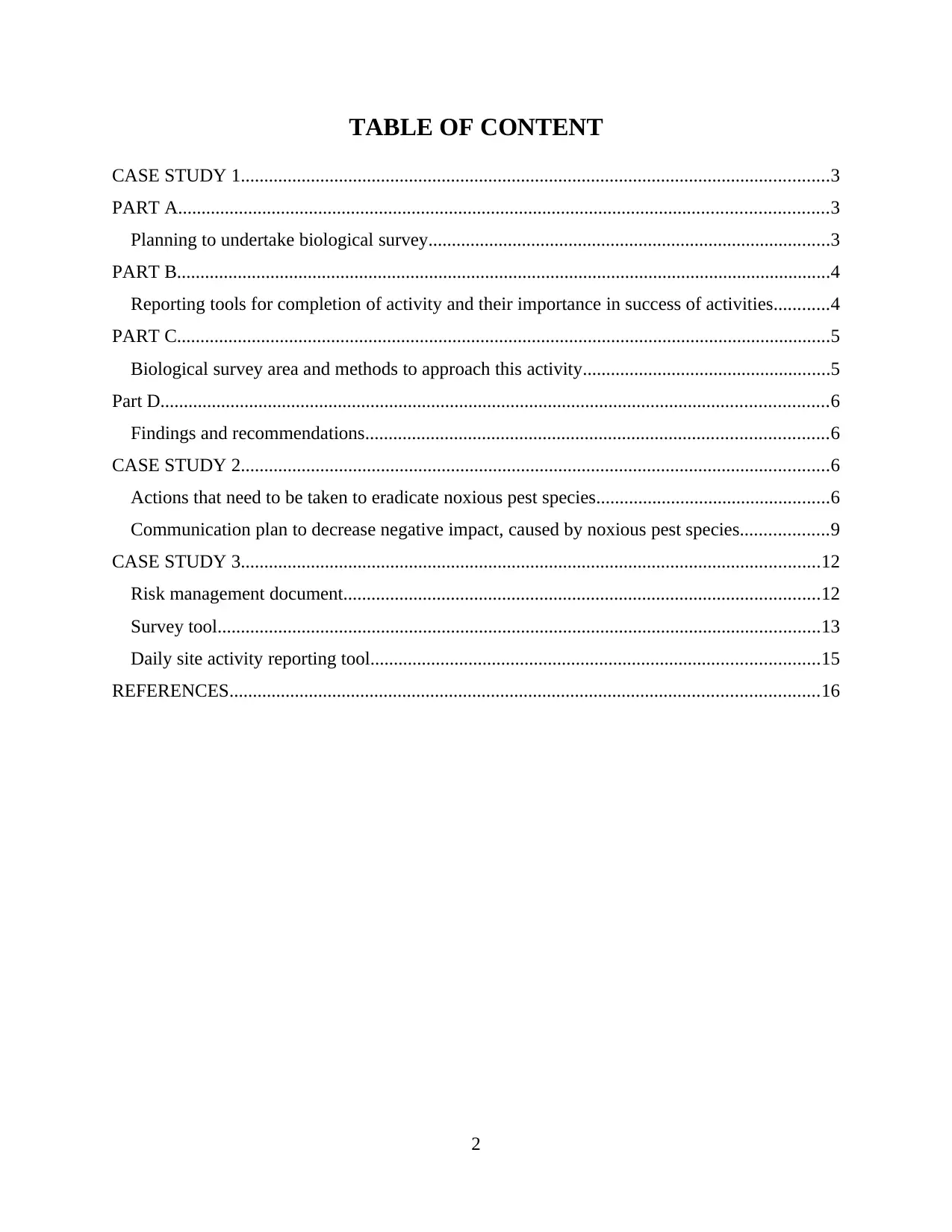
TABLE OF CONTENT
CASE STUDY 1..............................................................................................................................3
PART A...........................................................................................................................................3
Planning to undertake biological survey......................................................................................3
PART B............................................................................................................................................4
Reporting tools for completion of activity and their importance in success of activities............4
PART C............................................................................................................................................5
Biological survey area and methods to approach this activity.....................................................5
Part D...............................................................................................................................................6
Findings and recommendations...................................................................................................6
CASE STUDY 2..............................................................................................................................6
Actions that need to be taken to eradicate noxious pest species..................................................6
Communication plan to decrease negative impact, caused by noxious pest species...................9
CASE STUDY 3............................................................................................................................12
Risk management document......................................................................................................12
Survey tool.................................................................................................................................13
Daily site activity reporting tool................................................................................................15
REFERENCES..............................................................................................................................16
2
CASE STUDY 1..............................................................................................................................3
PART A...........................................................................................................................................3
Planning to undertake biological survey......................................................................................3
PART B............................................................................................................................................4
Reporting tools for completion of activity and their importance in success of activities............4
PART C............................................................................................................................................5
Biological survey area and methods to approach this activity.....................................................5
Part D...............................................................................................................................................6
Findings and recommendations...................................................................................................6
CASE STUDY 2..............................................................................................................................6
Actions that need to be taken to eradicate noxious pest species..................................................6
Communication plan to decrease negative impact, caused by noxious pest species...................9
CASE STUDY 3............................................................................................................................12
Risk management document......................................................................................................12
Survey tool.................................................................................................................................13
Daily site activity reporting tool................................................................................................15
REFERENCES..............................................................................................................................16
2
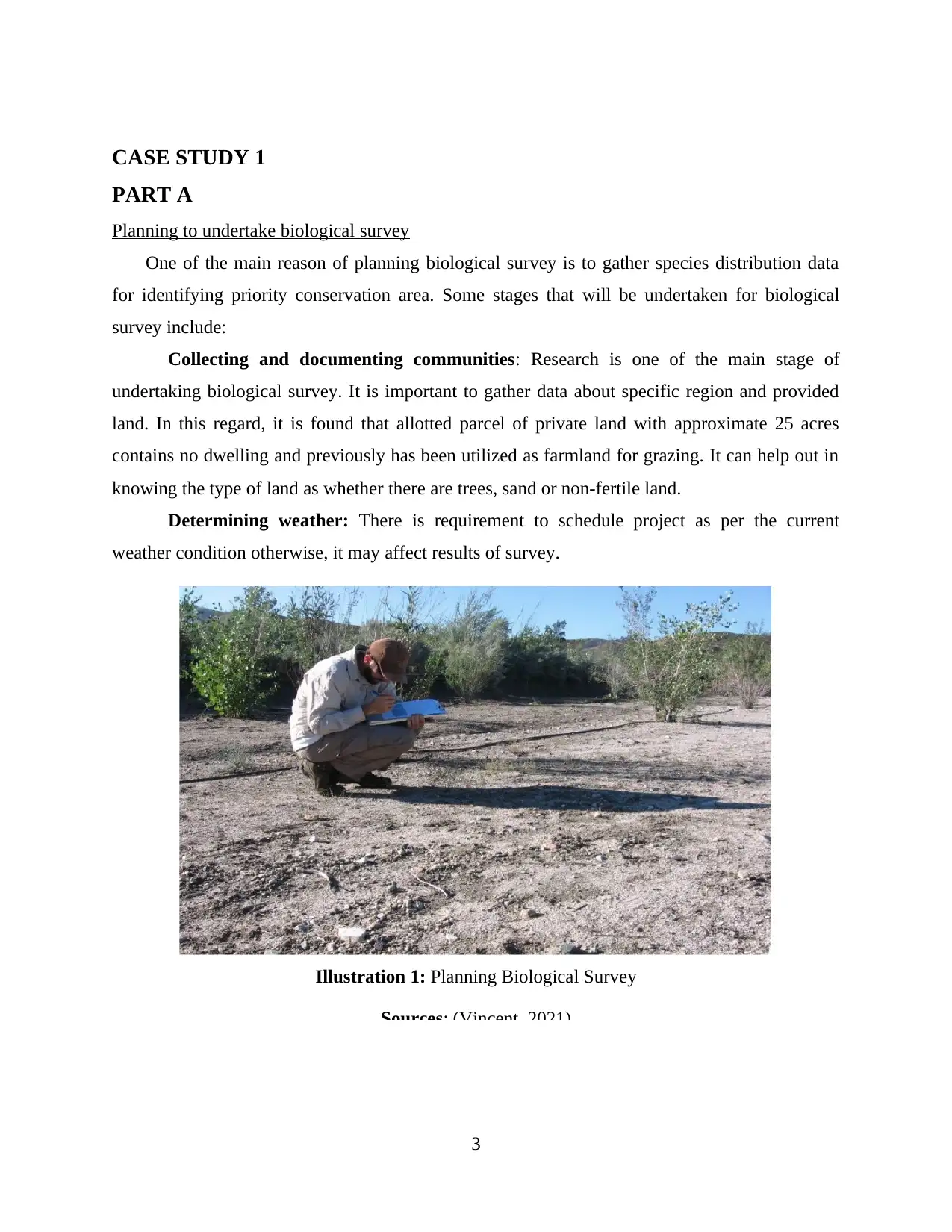
CASE STUDY 1
PART A
Planning to undertake biological survey
One of the main reason of planning biological survey is to gather species distribution data
for identifying priority conservation area. Some stages that will be undertaken for biological
survey include:
Collecting and documenting communities: Research is one of the main stage of
undertaking biological survey. It is important to gather data about specific region and provided
land. In this regard, it is found that allotted parcel of private land with approximate 25 acres
contains no dwelling and previously has been utilized as farmland for grazing. It can help out in
knowing the type of land as whether there are trees, sand or non-fertile land.
Determining weather: There is requirement to schedule project as per the current
weather condition otherwise, it may affect results of survey.
3
Illustration 1: Planning Biological Survey
Sources: (Vincent, 2021)
PART A
Planning to undertake biological survey
One of the main reason of planning biological survey is to gather species distribution data
for identifying priority conservation area. Some stages that will be undertaken for biological
survey include:
Collecting and documenting communities: Research is one of the main stage of
undertaking biological survey. It is important to gather data about specific region and provided
land. In this regard, it is found that allotted parcel of private land with approximate 25 acres
contains no dwelling and previously has been utilized as farmland for grazing. It can help out in
knowing the type of land as whether there are trees, sand or non-fertile land.
Determining weather: There is requirement to schedule project as per the current
weather condition otherwise, it may affect results of survey.
3
Illustration 1: Planning Biological Survey
Sources: (Vincent, 2021)
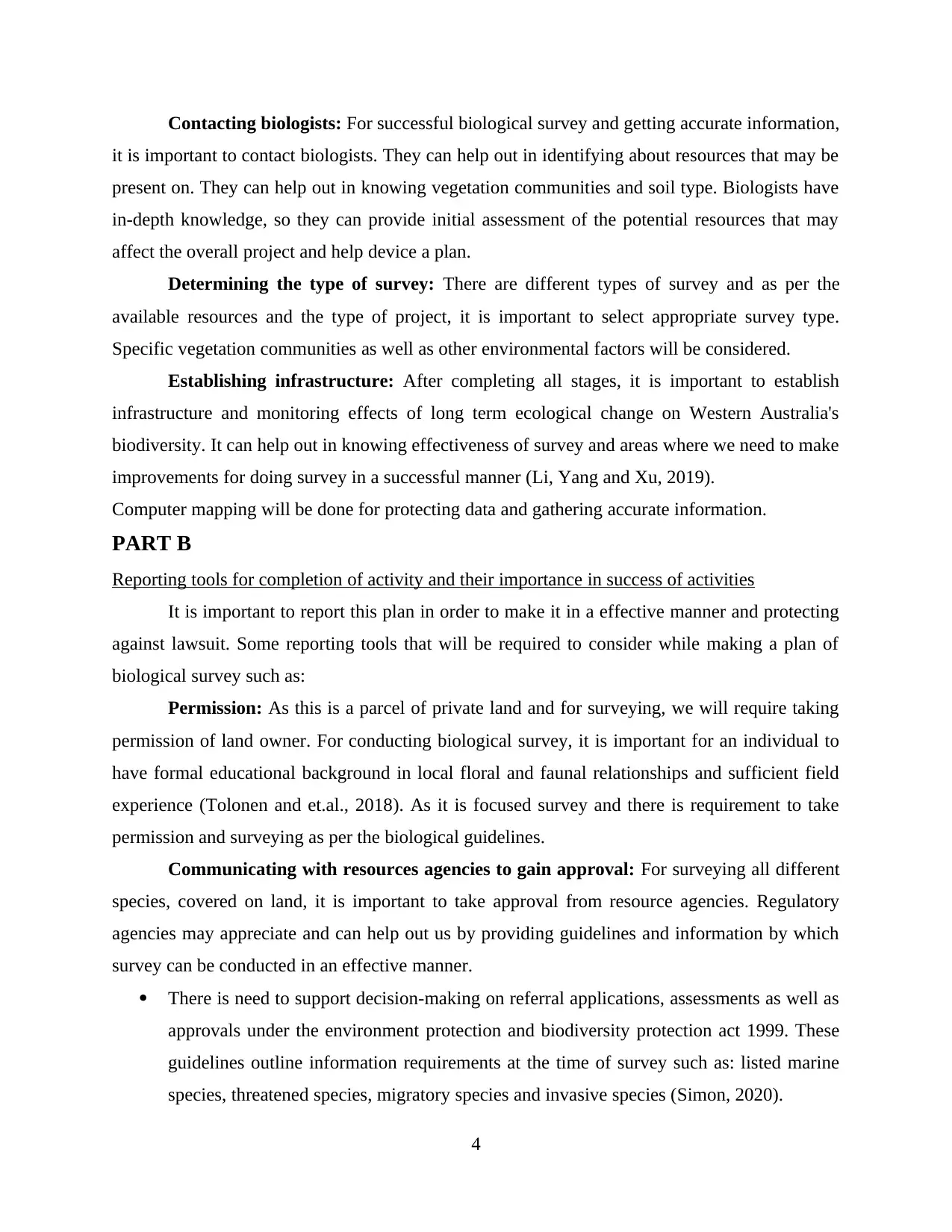
Contacting biologists: For successful biological survey and getting accurate information,
it is important to contact biologists. They can help out in identifying about resources that may be
present on. They can help out in knowing vegetation communities and soil type. Biologists have
in-depth knowledge, so they can provide initial assessment of the potential resources that may
affect the overall project and help device a plan.
Determining the type of survey: There are different types of survey and as per the
available resources and the type of project, it is important to select appropriate survey type.
Specific vegetation communities as well as other environmental factors will be considered.
Establishing infrastructure: After completing all stages, it is important to establish
infrastructure and monitoring effects of long term ecological change on Western Australia's
biodiversity. It can help out in knowing effectiveness of survey and areas where we need to make
improvements for doing survey in a successful manner (Li, Yang and Xu, 2019).
Computer mapping will be done for protecting data and gathering accurate information.
PART B
Reporting tools for completion of activity and their importance in success of activities
It is important to report this plan in order to make it in a effective manner and protecting
against lawsuit. Some reporting tools that will be required to consider while making a plan of
biological survey such as:
Permission: As this is a parcel of private land and for surveying, we will require taking
permission of land owner. For conducting biological survey, it is important for an individual to
have formal educational background in local floral and faunal relationships and sufficient field
experience (Tolonen and et.al., 2018). As it is focused survey and there is requirement to take
permission and surveying as per the biological guidelines.
Communicating with resources agencies to gain approval: For surveying all different
species, covered on land, it is important to take approval from resource agencies. Regulatory
agencies may appreciate and can help out us by providing guidelines and information by which
survey can be conducted in an effective manner.
There is need to support decision-making on referral applications, assessments as well as
approvals under the environment protection and biodiversity protection act 1999. These
guidelines outline information requirements at the time of survey such as: listed marine
species, threatened species, migratory species and invasive species (Simon, 2020).
4
it is important to contact biologists. They can help out in identifying about resources that may be
present on. They can help out in knowing vegetation communities and soil type. Biologists have
in-depth knowledge, so they can provide initial assessment of the potential resources that may
affect the overall project and help device a plan.
Determining the type of survey: There are different types of survey and as per the
available resources and the type of project, it is important to select appropriate survey type.
Specific vegetation communities as well as other environmental factors will be considered.
Establishing infrastructure: After completing all stages, it is important to establish
infrastructure and monitoring effects of long term ecological change on Western Australia's
biodiversity. It can help out in knowing effectiveness of survey and areas where we need to make
improvements for doing survey in a successful manner (Li, Yang and Xu, 2019).
Computer mapping will be done for protecting data and gathering accurate information.
PART B
Reporting tools for completion of activity and their importance in success of activities
It is important to report this plan in order to make it in a effective manner and protecting
against lawsuit. Some reporting tools that will be required to consider while making a plan of
biological survey such as:
Permission: As this is a parcel of private land and for surveying, we will require taking
permission of land owner. For conducting biological survey, it is important for an individual to
have formal educational background in local floral and faunal relationships and sufficient field
experience (Tolonen and et.al., 2018). As it is focused survey and there is requirement to take
permission and surveying as per the biological guidelines.
Communicating with resources agencies to gain approval: For surveying all different
species, covered on land, it is important to take approval from resource agencies. Regulatory
agencies may appreciate and can help out us by providing guidelines and information by which
survey can be conducted in an effective manner.
There is need to support decision-making on referral applications, assessments as well as
approvals under the environment protection and biodiversity protection act 1999. These
guidelines outline information requirements at the time of survey such as: listed marine
species, threatened species, migratory species and invasive species (Simon, 2020).
4
Secure Best Marks with AI Grader
Need help grading? Try our AI Grader for instant feedback on your assignments.
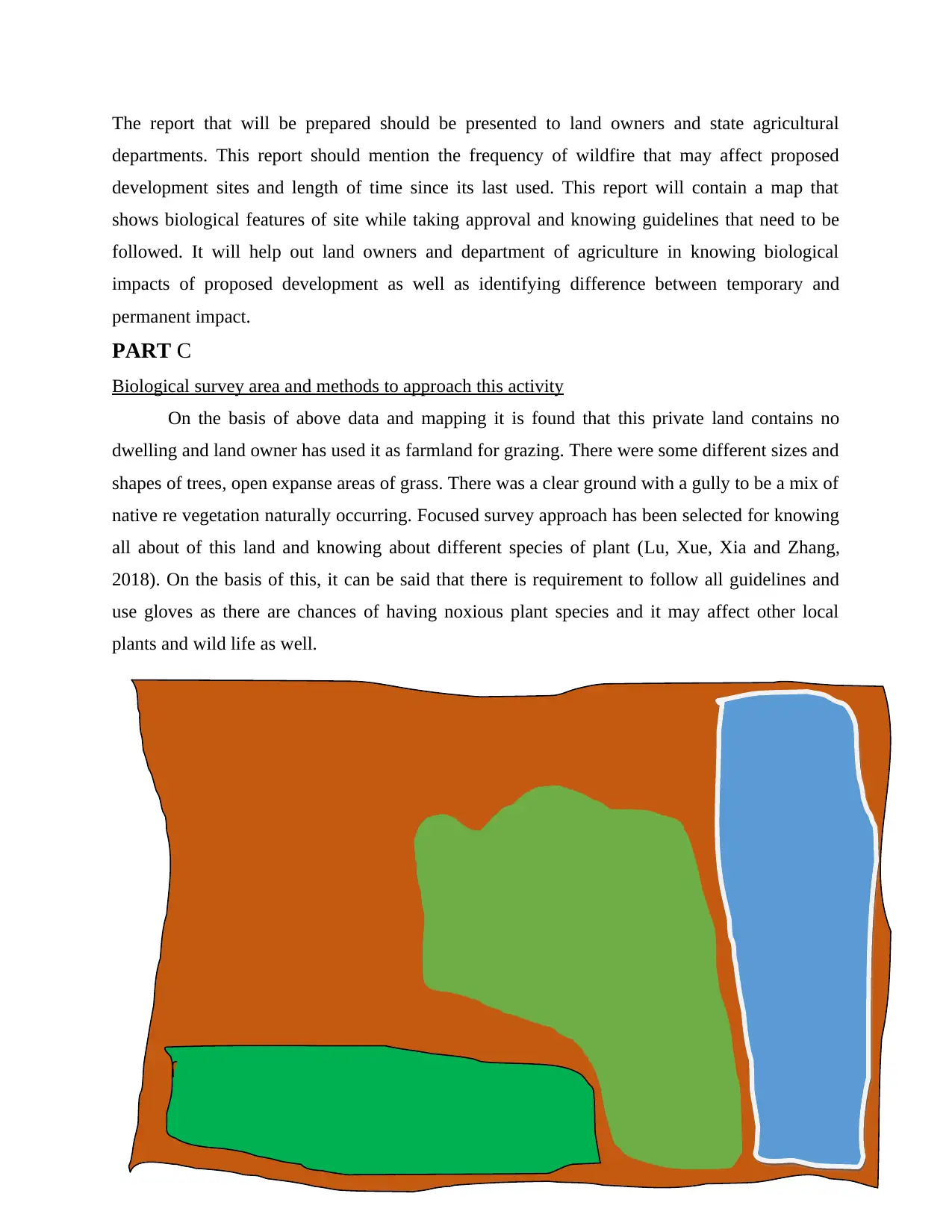
The report that will be prepared should be presented to land owners and state agricultural
departments. This report should mention the frequency of wildfire that may affect proposed
development sites and length of time since its last used. This report will contain a map that
shows biological features of site while taking approval and knowing guidelines that need to be
followed. It will help out land owners and department of agriculture in knowing biological
impacts of proposed development as well as identifying difference between temporary and
permanent impact.
PART C
Biological survey area and methods to approach this activity
On the basis of above data and mapping it is found that this private land contains no
dwelling and land owner has used it as farmland for grazing. There were some different sizes and
shapes of trees, open expanse areas of grass. There was a clear ground with a gully to be a mix of
native re vegetation naturally occurring. Focused survey approach has been selected for knowing
all about of this land and knowing about different species of plant (Lu, Xue, Xia and Zhang,
2018). On the basis of this, it can be said that there is requirement to follow all guidelines and
use gloves as there are chances of having noxious plant species and it may affect other local
plants and wild life as well.
5
departments. This report should mention the frequency of wildfire that may affect proposed
development sites and length of time since its last used. This report will contain a map that
shows biological features of site while taking approval and knowing guidelines that need to be
followed. It will help out land owners and department of agriculture in knowing biological
impacts of proposed development as well as identifying difference between temporary and
permanent impact.
PART C
Biological survey area and methods to approach this activity
On the basis of above data and mapping it is found that this private land contains no
dwelling and land owner has used it as farmland for grazing. There were some different sizes and
shapes of trees, open expanse areas of grass. There was a clear ground with a gully to be a mix of
native re vegetation naturally occurring. Focused survey approach has been selected for knowing
all about of this land and knowing about different species of plant (Lu, Xue, Xia and Zhang,
2018). On the basis of this, it can be said that there is requirement to follow all guidelines and
use gloves as there are chances of having noxious plant species and it may affect other local
plants and wild life as well.
5
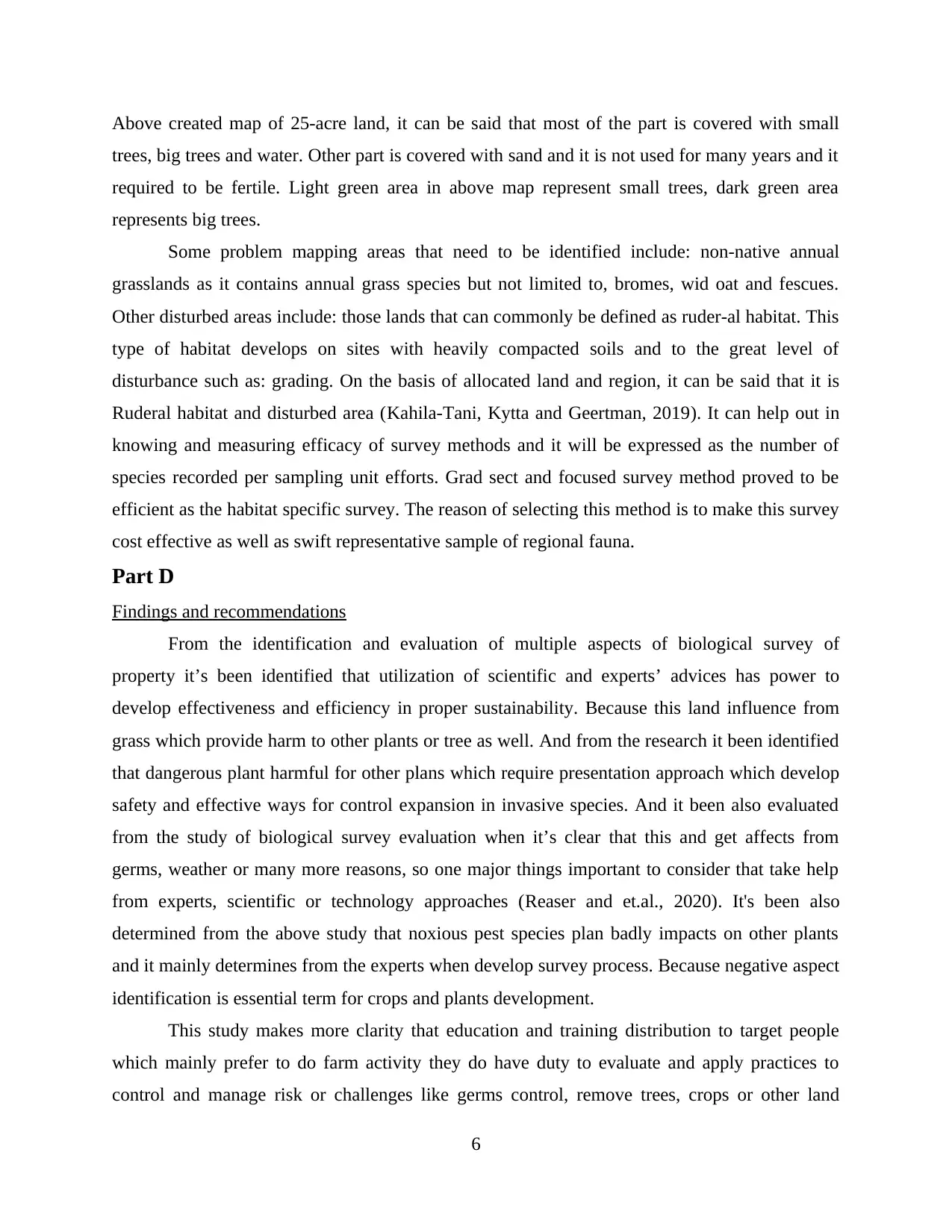
Above created map of 25-acre land, it can be said that most of the part is covered with small
trees, big trees and water. Other part is covered with sand and it is not used for many years and it
required to be fertile. Light green area in above map represent small trees, dark green area
represents big trees.
Some problem mapping areas that need to be identified include: non-native annual
grasslands as it contains annual grass species but not limited to, bromes, wid oat and fescues.
Other disturbed areas include: those lands that can commonly be defined as ruder-al habitat. This
type of habitat develops on sites with heavily compacted soils and to the great level of
disturbance such as: grading. On the basis of allocated land and region, it can be said that it is
Ruderal habitat and disturbed area (Kahila-Tani, Kytta and Geertman, 2019). It can help out in
knowing and measuring efficacy of survey methods and it will be expressed as the number of
species recorded per sampling unit efforts. Grad sect and focused survey method proved to be
efficient as the habitat specific survey. The reason of selecting this method is to make this survey
cost effective as well as swift representative sample of regional fauna.
Part D
Findings and recommendations
From the identification and evaluation of multiple aspects of biological survey of
property it’s been identified that utilization of scientific and experts’ advices has power to
develop effectiveness and efficiency in proper sustainability. Because this land influence from
grass which provide harm to other plants or tree as well. And from the research it been identified
that dangerous plant harmful for other plans which require presentation approach which develop
safety and effective ways for control expansion in invasive species. And it been also evaluated
from the study of biological survey evaluation when it’s clear that this and get affects from
germs, weather or many more reasons, so one major things important to consider that take help
from experts, scientific or technology approaches (Reaser and et.al., 2020). It's been also
determined from the above study that noxious pest species plan badly impacts on other plants
and it mainly determines from the experts when develop survey process. Because negative aspect
identification is essential term for crops and plants development.
This study makes more clarity that education and training distribution to target people
which mainly prefer to do farm activity they do have duty to evaluate and apply practices to
control and manage risk or challenges like germs control, remove trees, crops or other land
6
trees, big trees and water. Other part is covered with sand and it is not used for many years and it
required to be fertile. Light green area in above map represent small trees, dark green area
represents big trees.
Some problem mapping areas that need to be identified include: non-native annual
grasslands as it contains annual grass species but not limited to, bromes, wid oat and fescues.
Other disturbed areas include: those lands that can commonly be defined as ruder-al habitat. This
type of habitat develops on sites with heavily compacted soils and to the great level of
disturbance such as: grading. On the basis of allocated land and region, it can be said that it is
Ruderal habitat and disturbed area (Kahila-Tani, Kytta and Geertman, 2019). It can help out in
knowing and measuring efficacy of survey methods and it will be expressed as the number of
species recorded per sampling unit efforts. Grad sect and focused survey method proved to be
efficient as the habitat specific survey. The reason of selecting this method is to make this survey
cost effective as well as swift representative sample of regional fauna.
Part D
Findings and recommendations
From the identification and evaluation of multiple aspects of biological survey of
property it’s been identified that utilization of scientific and experts’ advices has power to
develop effectiveness and efficiency in proper sustainability. Because this land influence from
grass which provide harm to other plants or tree as well. And from the research it been identified
that dangerous plant harmful for other plans which require presentation approach which develop
safety and effective ways for control expansion in invasive species. And it been also evaluated
from the study of biological survey evaluation when it’s clear that this and get affects from
germs, weather or many more reasons, so one major things important to consider that take help
from experts, scientific or technology approaches (Reaser and et.al., 2020). It's been also
determined from the above study that noxious pest species plan badly impacts on other plants
and it mainly determines from the experts when develop survey process. Because negative aspect
identification is essential term for crops and plants development.
This study makes more clarity that education and training distribution to target people
which mainly prefer to do farm activity they do have duty to evaluate and apply practices to
control and manage risk or challenges like germs control, remove trees, crops or other land
6
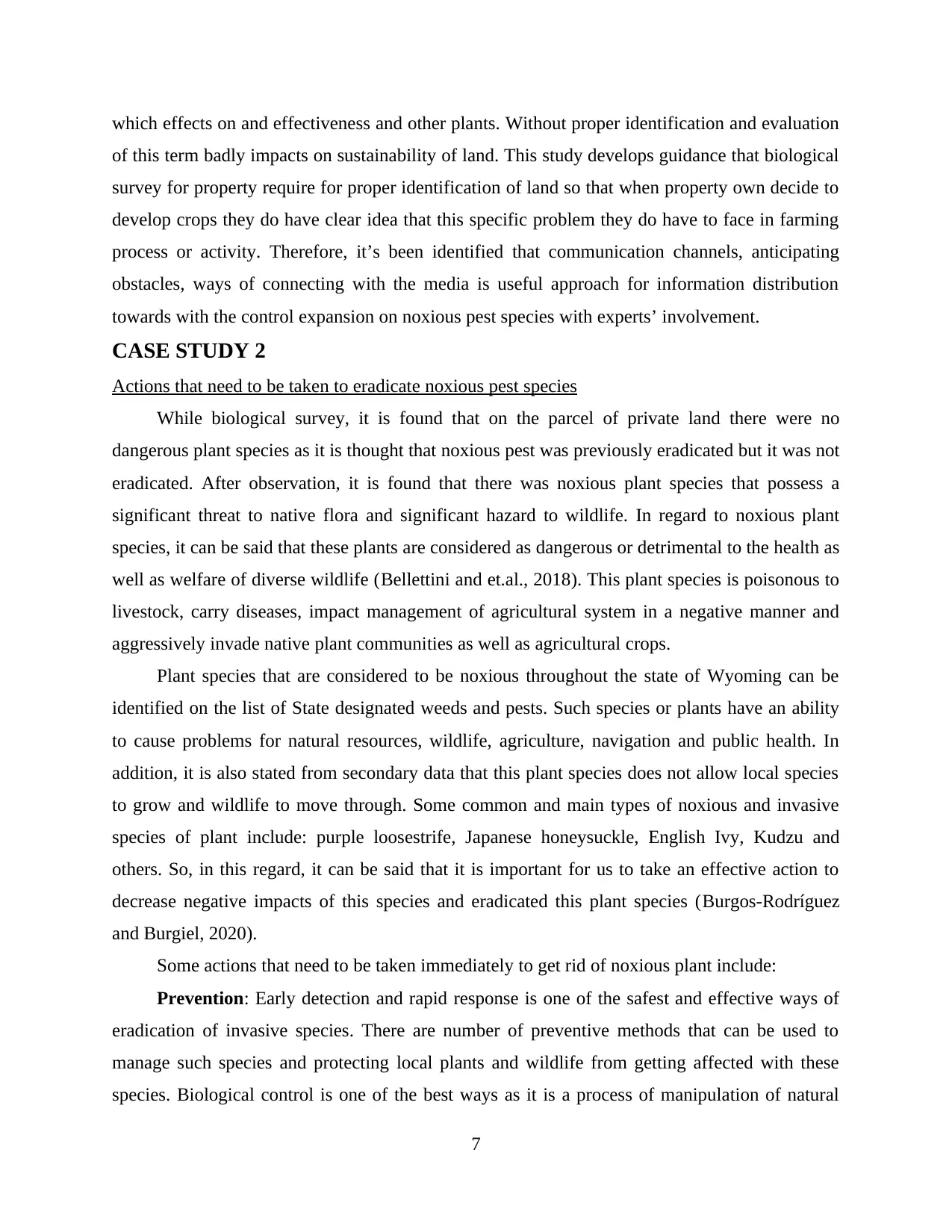
which effects on and effectiveness and other plants. Without proper identification and evaluation
of this term badly impacts on sustainability of land. This study develops guidance that biological
survey for property require for proper identification of land so that when property own decide to
develop crops they do have clear idea that this specific problem they do have to face in farming
process or activity. Therefore, it’s been identified that communication channels, anticipating
obstacles, ways of connecting with the media is useful approach for information distribution
towards with the control expansion on noxious pest species with experts’ involvement.
CASE STUDY 2
Actions that need to be taken to eradicate noxious pest species
While biological survey, it is found that on the parcel of private land there were no
dangerous plant species as it is thought that noxious pest was previously eradicated but it was not
eradicated. After observation, it is found that there was noxious plant species that possess a
significant threat to native flora and significant hazard to wildlife. In regard to noxious plant
species, it can be said that these plants are considered as dangerous or detrimental to the health as
well as welfare of diverse wildlife (Bellettini and et.al., 2018). This plant species is poisonous to
livestock, carry diseases, impact management of agricultural system in a negative manner and
aggressively invade native plant communities as well as agricultural crops.
Plant species that are considered to be noxious throughout the state of Wyoming can be
identified on the list of State designated weeds and pests. Such species or plants have an ability
to cause problems for natural resources, wildlife, agriculture, navigation and public health. In
addition, it is also stated from secondary data that this plant species does not allow local species
to grow and wildlife to move through. Some common and main types of noxious and invasive
species of plant include: purple loosestrife, Japanese honeysuckle, English Ivy, Kudzu and
others. So, in this regard, it can be said that it is important for us to take an effective action to
decrease negative impacts of this species and eradicated this plant species (Burgos-Rodríguez
and Burgiel, 2020).
Some actions that need to be taken immediately to get rid of noxious plant include:
Prevention: Early detection and rapid response is one of the safest and effective ways of
eradication of invasive species. There are number of preventive methods that can be used to
manage such species and protecting local plants and wildlife from getting affected with these
species. Biological control is one of the best ways as it is a process of manipulation of natural
7
of this term badly impacts on sustainability of land. This study develops guidance that biological
survey for property require for proper identification of land so that when property own decide to
develop crops they do have clear idea that this specific problem they do have to face in farming
process or activity. Therefore, it’s been identified that communication channels, anticipating
obstacles, ways of connecting with the media is useful approach for information distribution
towards with the control expansion on noxious pest species with experts’ involvement.
CASE STUDY 2
Actions that need to be taken to eradicate noxious pest species
While biological survey, it is found that on the parcel of private land there were no
dangerous plant species as it is thought that noxious pest was previously eradicated but it was not
eradicated. After observation, it is found that there was noxious plant species that possess a
significant threat to native flora and significant hazard to wildlife. In regard to noxious plant
species, it can be said that these plants are considered as dangerous or detrimental to the health as
well as welfare of diverse wildlife (Bellettini and et.al., 2018). This plant species is poisonous to
livestock, carry diseases, impact management of agricultural system in a negative manner and
aggressively invade native plant communities as well as agricultural crops.
Plant species that are considered to be noxious throughout the state of Wyoming can be
identified on the list of State designated weeds and pests. Such species or plants have an ability
to cause problems for natural resources, wildlife, agriculture, navigation and public health. In
addition, it is also stated from secondary data that this plant species does not allow local species
to grow and wildlife to move through. Some common and main types of noxious and invasive
species of plant include: purple loosestrife, Japanese honeysuckle, English Ivy, Kudzu and
others. So, in this regard, it can be said that it is important for us to take an effective action to
decrease negative impacts of this species and eradicated this plant species (Burgos-Rodríguez
and Burgiel, 2020).
Some actions that need to be taken immediately to get rid of noxious plant include:
Prevention: Early detection and rapid response is one of the safest and effective ways of
eradication of invasive species. There are number of preventive methods that can be used to
manage such species and protecting local plants and wildlife from getting affected with these
species. Biological control is one of the best ways as it is a process of manipulation of natural
7
Paraphrase This Document
Need a fresh take? Get an instant paraphrase of this document with our AI Paraphraser
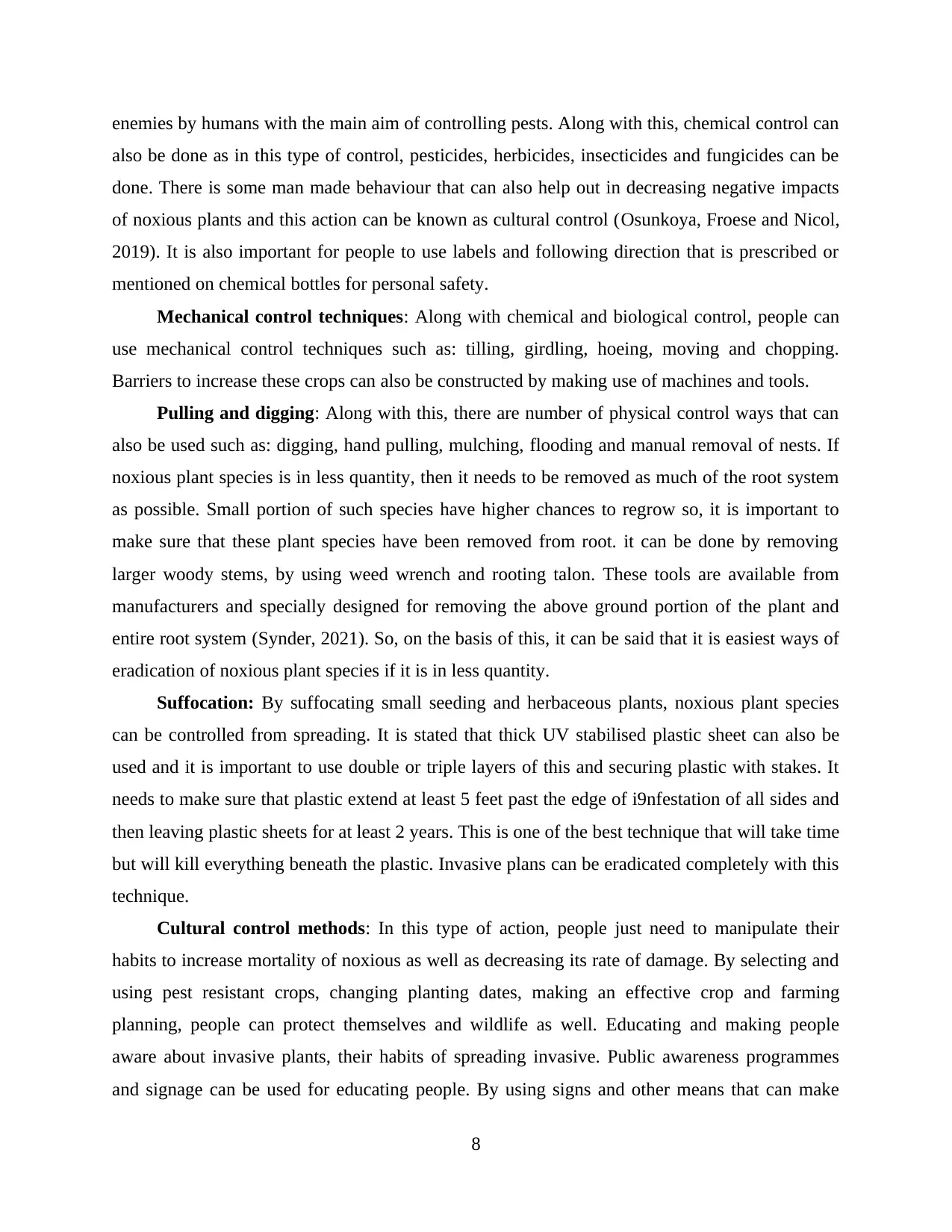
enemies by humans with the main aim of controlling pests. Along with this, chemical control can
also be done as in this type of control, pesticides, herbicides, insecticides and fungicides can be
done. There is some man made behaviour that can also help out in decreasing negative impacts
of noxious plants and this action can be known as cultural control (Osunkoya, Froese and Nicol,
2019). It is also important for people to use labels and following direction that is prescribed or
mentioned on chemical bottles for personal safety.
Mechanical control techniques: Along with chemical and biological control, people can
use mechanical control techniques such as: tilling, girdling, hoeing, moving and chopping.
Barriers to increase these crops can also be constructed by making use of machines and tools.
Pulling and digging: Along with this, there are number of physical control ways that can
also be used such as: digging, hand pulling, mulching, flooding and manual removal of nests. If
noxious plant species is in less quantity, then it needs to be removed as much of the root system
as possible. Small portion of such species have higher chances to regrow so, it is important to
make sure that these plant species have been removed from root. it can be done by removing
larger woody stems, by using weed wrench and rooting talon. These tools are available from
manufacturers and specially designed for removing the above ground portion of the plant and
entire root system (Synder, 2021). So, on the basis of this, it can be said that it is easiest ways of
eradication of noxious plant species if it is in less quantity.
Suffocation: By suffocating small seeding and herbaceous plants, noxious plant species
can be controlled from spreading. It is stated that thick UV stabilised plastic sheet can also be
used and it is important to use double or triple layers of this and securing plastic with stakes. It
needs to make sure that plastic extend at least 5 feet past the edge of i9nfestation of all sides and
then leaving plastic sheets for at least 2 years. This is one of the best technique that will take time
but will kill everything beneath the plastic. Invasive plans can be eradicated completely with this
technique.
Cultural control methods: In this type of action, people just need to manipulate their
habits to increase mortality of noxious as well as decreasing its rate of damage. By selecting and
using pest resistant crops, changing planting dates, making an effective crop and farming
planning, people can protect themselves and wildlife as well. Educating and making people
aware about invasive plants, their habits of spreading invasive. Public awareness programmes
and signage can be used for educating people. By using signs and other means that can make
8
also be done as in this type of control, pesticides, herbicides, insecticides and fungicides can be
done. There is some man made behaviour that can also help out in decreasing negative impacts
of noxious plants and this action can be known as cultural control (Osunkoya, Froese and Nicol,
2019). It is also important for people to use labels and following direction that is prescribed or
mentioned on chemical bottles for personal safety.
Mechanical control techniques: Along with chemical and biological control, people can
use mechanical control techniques such as: tilling, girdling, hoeing, moving and chopping.
Barriers to increase these crops can also be constructed by making use of machines and tools.
Pulling and digging: Along with this, there are number of physical control ways that can
also be used such as: digging, hand pulling, mulching, flooding and manual removal of nests. If
noxious plant species is in less quantity, then it needs to be removed as much of the root system
as possible. Small portion of such species have higher chances to regrow so, it is important to
make sure that these plant species have been removed from root. it can be done by removing
larger woody stems, by using weed wrench and rooting talon. These tools are available from
manufacturers and specially designed for removing the above ground portion of the plant and
entire root system (Synder, 2021). So, on the basis of this, it can be said that it is easiest ways of
eradication of noxious plant species if it is in less quantity.
Suffocation: By suffocating small seeding and herbaceous plants, noxious plant species
can be controlled from spreading. It is stated that thick UV stabilised plastic sheet can also be
used and it is important to use double or triple layers of this and securing plastic with stakes. It
needs to make sure that plastic extend at least 5 feet past the edge of i9nfestation of all sides and
then leaving plastic sheets for at least 2 years. This is one of the best technique that will take time
but will kill everything beneath the plastic. Invasive plans can be eradicated completely with this
technique.
Cultural control methods: In this type of action, people just need to manipulate their
habits to increase mortality of noxious as well as decreasing its rate of damage. By selecting and
using pest resistant crops, changing planting dates, making an effective crop and farming
planning, people can protect themselves and wildlife as well. Educating and making people
aware about invasive plants, their habits of spreading invasive. Public awareness programmes
and signage can be used for educating people. By using signs and other means that can make
8
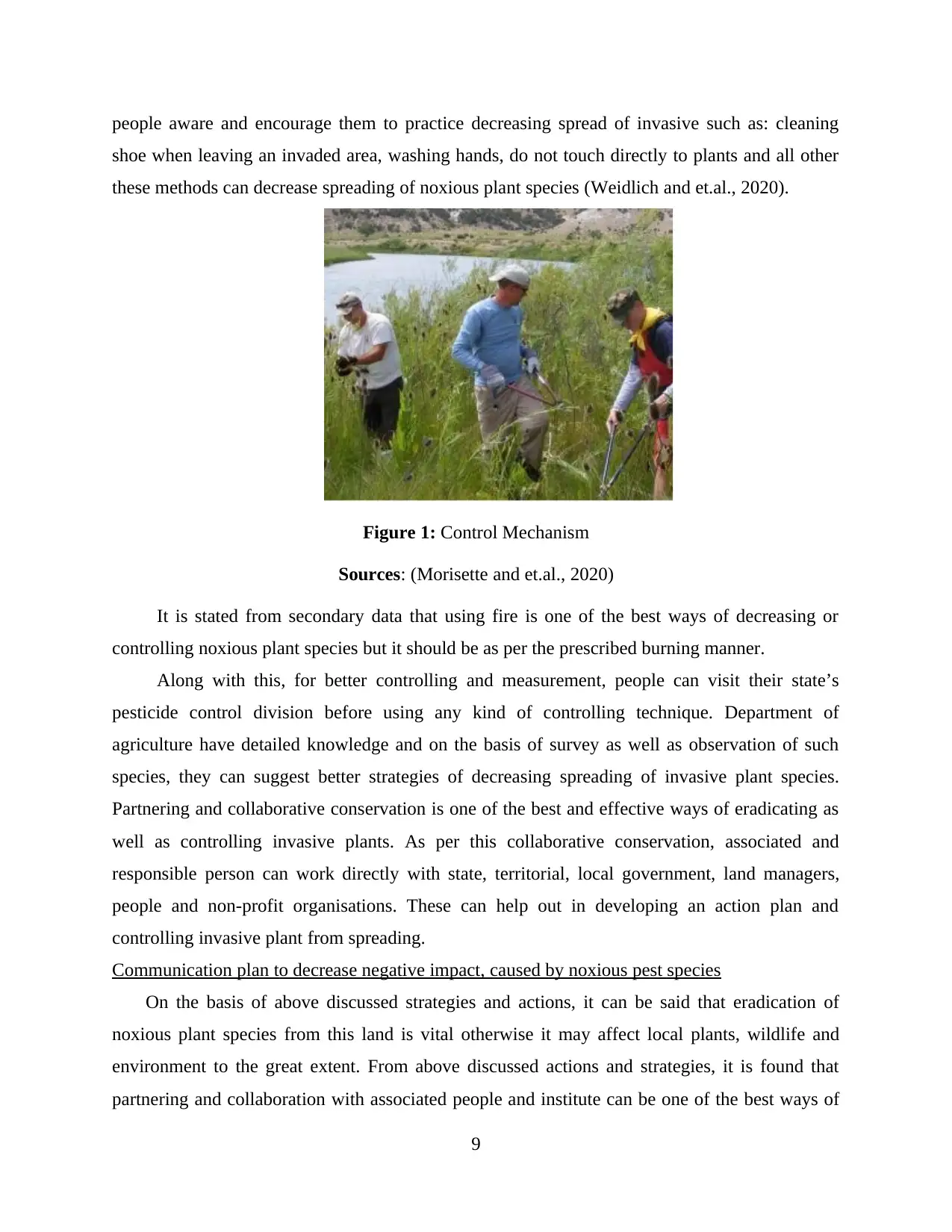
people aware and encourage them to practice decreasing spread of invasive such as: cleaning
shoe when leaving an invaded area, washing hands, do not touch directly to plants and all other
these methods can decrease spreading of noxious plant species (Weidlich and et.al., 2020).
Figure 1: Control Mechanism
Sources: (Morisette and et.al., 2020)
It is stated from secondary data that using fire is one of the best ways of decreasing or
controlling noxious plant species but it should be as per the prescribed burning manner.
Along with this, for better controlling and measurement, people can visit their state’s
pesticide control division before using any kind of controlling technique. Department of
agriculture have detailed knowledge and on the basis of survey as well as observation of such
species, they can suggest better strategies of decreasing spreading of invasive plant species.
Partnering and collaborative conservation is one of the best and effective ways of eradicating as
well as controlling invasive plants. As per this collaborative conservation, associated and
responsible person can work directly with state, territorial, local government, land managers,
people and non-profit organisations. These can help out in developing an action plan and
controlling invasive plant from spreading.
Communication plan to decrease negative impact, caused by noxious pest species
On the basis of above discussed strategies and actions, it can be said that eradication of
noxious plant species from this land is vital otherwise it may affect local plants, wildlife and
environment to the great extent. From above discussed actions and strategies, it is found that
partnering and collaboration with associated people and institute can be one of the best ways of
9
shoe when leaving an invaded area, washing hands, do not touch directly to plants and all other
these methods can decrease spreading of noxious plant species (Weidlich and et.al., 2020).
Figure 1: Control Mechanism
Sources: (Morisette and et.al., 2020)
It is stated from secondary data that using fire is one of the best ways of decreasing or
controlling noxious plant species but it should be as per the prescribed burning manner.
Along with this, for better controlling and measurement, people can visit their state’s
pesticide control division before using any kind of controlling technique. Department of
agriculture have detailed knowledge and on the basis of survey as well as observation of such
species, they can suggest better strategies of decreasing spreading of invasive plant species.
Partnering and collaborative conservation is one of the best and effective ways of eradicating as
well as controlling invasive plants. As per this collaborative conservation, associated and
responsible person can work directly with state, territorial, local government, land managers,
people and non-profit organisations. These can help out in developing an action plan and
controlling invasive plant from spreading.
Communication plan to decrease negative impact, caused by noxious pest species
On the basis of above discussed strategies and actions, it can be said that eradication of
noxious plant species from this land is vital otherwise it may affect local plants, wildlife and
environment to the great extent. From above discussed actions and strategies, it is found that
partnering and collaboration with associated people and institute can be one of the best ways of
9
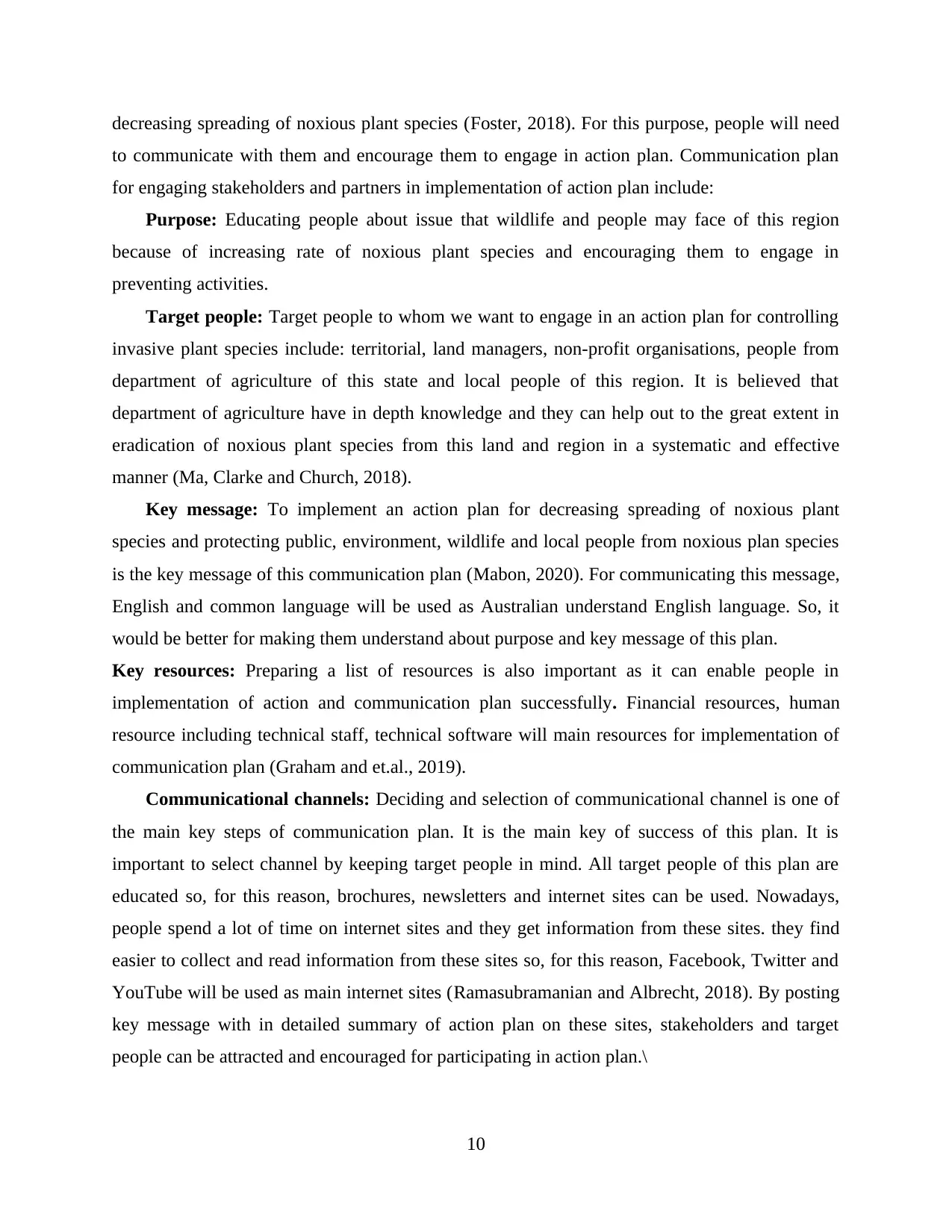
decreasing spreading of noxious plant species (Foster, 2018). For this purpose, people will need
to communicate with them and encourage them to engage in action plan. Communication plan
for engaging stakeholders and partners in implementation of action plan include:
Purpose: Educating people about issue that wildlife and people may face of this region
because of increasing rate of noxious plant species and encouraging them to engage in
preventing activities.
Target people: Target people to whom we want to engage in an action plan for controlling
invasive plant species include: territorial, land managers, non-profit organisations, people from
department of agriculture of this state and local people of this region. It is believed that
department of agriculture have in depth knowledge and they can help out to the great extent in
eradication of noxious plant species from this land and region in a systematic and effective
manner (Ma, Clarke and Church, 2018).
Key message: To implement an action plan for decreasing spreading of noxious plant
species and protecting public, environment, wildlife and local people from noxious plan species
is the key message of this communication plan (Mabon, 2020). For communicating this message,
English and common language will be used as Australian understand English language. So, it
would be better for making them understand about purpose and key message of this plan.
Key resources: Preparing a list of resources is also important as it can enable people in
implementation of action and communication plan successfully. Financial resources, human
resource including technical staff, technical software will main resources for implementation of
communication plan (Graham and et.al., 2019).
Communicational channels: Deciding and selection of communicational channel is one of
the main key steps of communication plan. It is the main key of success of this plan. It is
important to select channel by keeping target people in mind. All target people of this plan are
educated so, for this reason, brochures, newsletters and internet sites can be used. Nowadays,
people spend a lot of time on internet sites and they get information from these sites. they find
easier to collect and read information from these sites so, for this reason, Facebook, Twitter and
YouTube will be used as main internet sites (Ramasubramanian and Albrecht, 2018). By posting
key message with in detailed summary of action plan on these sites, stakeholders and target
people can be attracted and encouraged for participating in action plan.\
10
to communicate with them and encourage them to engage in action plan. Communication plan
for engaging stakeholders and partners in implementation of action plan include:
Purpose: Educating people about issue that wildlife and people may face of this region
because of increasing rate of noxious plant species and encouraging them to engage in
preventing activities.
Target people: Target people to whom we want to engage in an action plan for controlling
invasive plant species include: territorial, land managers, non-profit organisations, people from
department of agriculture of this state and local people of this region. It is believed that
department of agriculture have in depth knowledge and they can help out to the great extent in
eradication of noxious plant species from this land and region in a systematic and effective
manner (Ma, Clarke and Church, 2018).
Key message: To implement an action plan for decreasing spreading of noxious plant
species and protecting public, environment, wildlife and local people from noxious plan species
is the key message of this communication plan (Mabon, 2020). For communicating this message,
English and common language will be used as Australian understand English language. So, it
would be better for making them understand about purpose and key message of this plan.
Key resources: Preparing a list of resources is also important as it can enable people in
implementation of action and communication plan successfully. Financial resources, human
resource including technical staff, technical software will main resources for implementation of
communication plan (Graham and et.al., 2019).
Communicational channels: Deciding and selection of communicational channel is one of
the main key steps of communication plan. It is the main key of success of this plan. It is
important to select channel by keeping target people in mind. All target people of this plan are
educated so, for this reason, brochures, newsletters and internet sites can be used. Nowadays,
people spend a lot of time on internet sites and they get information from these sites. they find
easier to collect and read information from these sites so, for this reason, Facebook, Twitter and
YouTube will be used as main internet sites (Ramasubramanian and Albrecht, 2018). By posting
key message with in detailed summary of action plan on these sites, stakeholders and target
people can be attracted and encouraged for participating in action plan.\
10
Secure Best Marks with AI Grader
Need help grading? Try our AI Grader for instant feedback on your assignments.
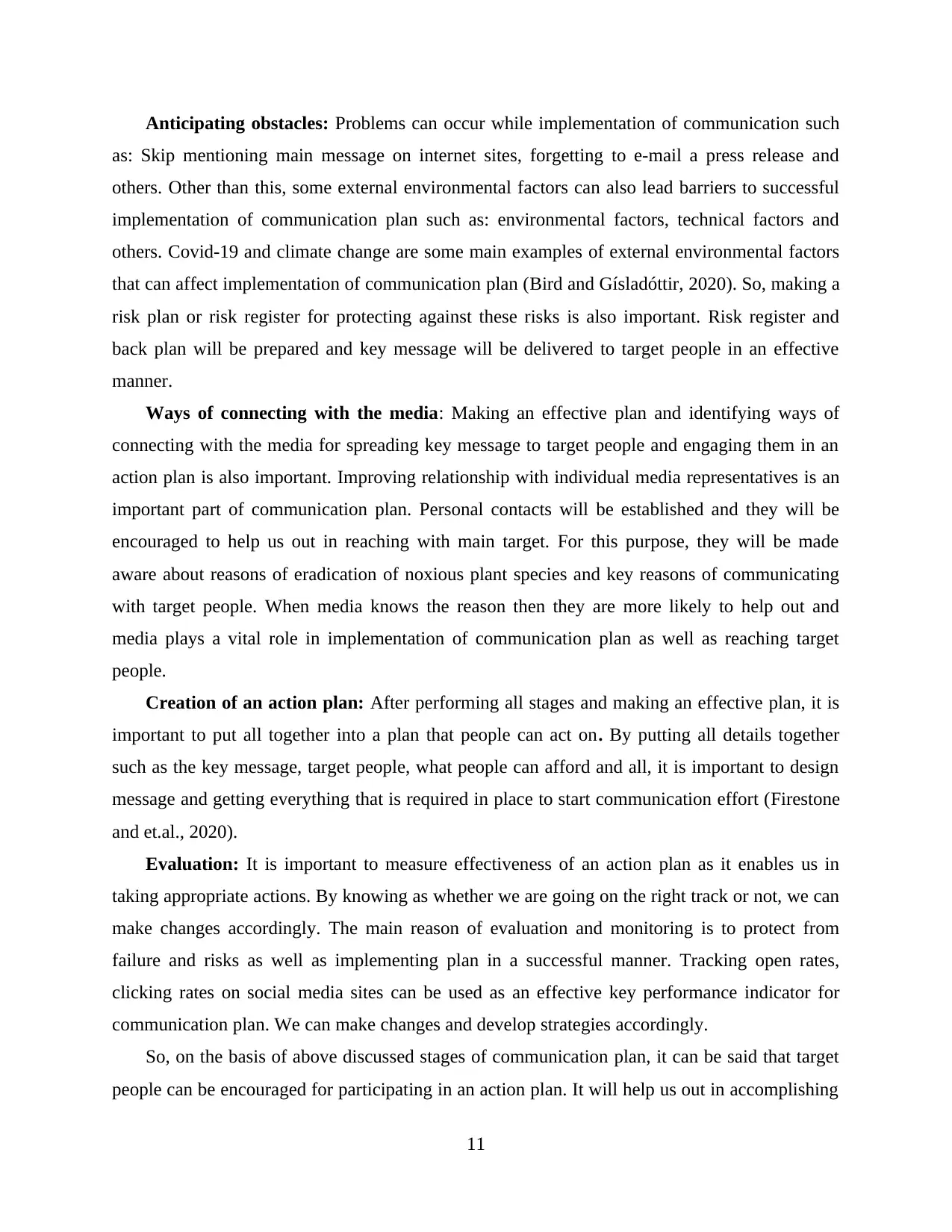
Anticipating obstacles: Problems can occur while implementation of communication such
as: Skip mentioning main message on internet sites, forgetting to e-mail a press release and
others. Other than this, some external environmental factors can also lead barriers to successful
implementation of communication plan such as: environmental factors, technical factors and
others. Covid-19 and climate change are some main examples of external environmental factors
that can affect implementation of communication plan (Bird and Gísladóttir, 2020). So, making a
risk plan or risk register for protecting against these risks is also important. Risk register and
back plan will be prepared and key message will be delivered to target people in an effective
manner.
Ways of connecting with the media: Making an effective plan and identifying ways of
connecting with the media for spreading key message to target people and engaging them in an
action plan is also important. Improving relationship with individual media representatives is an
important part of communication plan. Personal contacts will be established and they will be
encouraged to help us out in reaching with main target. For this purpose, they will be made
aware about reasons of eradication of noxious plant species and key reasons of communicating
with target people. When media knows the reason then they are more likely to help out and
media plays a vital role in implementation of communication plan as well as reaching target
people.
Creation of an action plan: After performing all stages and making an effective plan, it is
important to put all together into a plan that people can act on. By putting all details together
such as the key message, target people, what people can afford and all, it is important to design
message and getting everything that is required in place to start communication effort (Firestone
and et.al., 2020).
Evaluation: It is important to measure effectiveness of an action plan as it enables us in
taking appropriate actions. By knowing as whether we are going on the right track or not, we can
make changes accordingly. The main reason of evaluation and monitoring is to protect from
failure and risks as well as implementing plan in a successful manner. Tracking open rates,
clicking rates on social media sites can be used as an effective key performance indicator for
communication plan. We can make changes and develop strategies accordingly.
So, on the basis of above discussed stages of communication plan, it can be said that target
people can be encouraged for participating in an action plan. It will help us out in accomplishing
11
as: Skip mentioning main message on internet sites, forgetting to e-mail a press release and
others. Other than this, some external environmental factors can also lead barriers to successful
implementation of communication plan such as: environmental factors, technical factors and
others. Covid-19 and climate change are some main examples of external environmental factors
that can affect implementation of communication plan (Bird and Gísladóttir, 2020). So, making a
risk plan or risk register for protecting against these risks is also important. Risk register and
back plan will be prepared and key message will be delivered to target people in an effective
manner.
Ways of connecting with the media: Making an effective plan and identifying ways of
connecting with the media for spreading key message to target people and engaging them in an
action plan is also important. Improving relationship with individual media representatives is an
important part of communication plan. Personal contacts will be established and they will be
encouraged to help us out in reaching with main target. For this purpose, they will be made
aware about reasons of eradication of noxious plant species and key reasons of communicating
with target people. When media knows the reason then they are more likely to help out and
media plays a vital role in implementation of communication plan as well as reaching target
people.
Creation of an action plan: After performing all stages and making an effective plan, it is
important to put all together into a plan that people can act on. By putting all details together
such as the key message, target people, what people can afford and all, it is important to design
message and getting everything that is required in place to start communication effort (Firestone
and et.al., 2020).
Evaluation: It is important to measure effectiveness of an action plan as it enables us in
taking appropriate actions. By knowing as whether we are going on the right track or not, we can
make changes accordingly. The main reason of evaluation and monitoring is to protect from
failure and risks as well as implementing plan in a successful manner. Tracking open rates,
clicking rates on social media sites can be used as an effective key performance indicator for
communication plan. We can make changes and develop strategies accordingly.
So, on the basis of above discussed stages of communication plan, it can be said that target
people can be encouraged for participating in an action plan. It will help us out in accomplishing
11
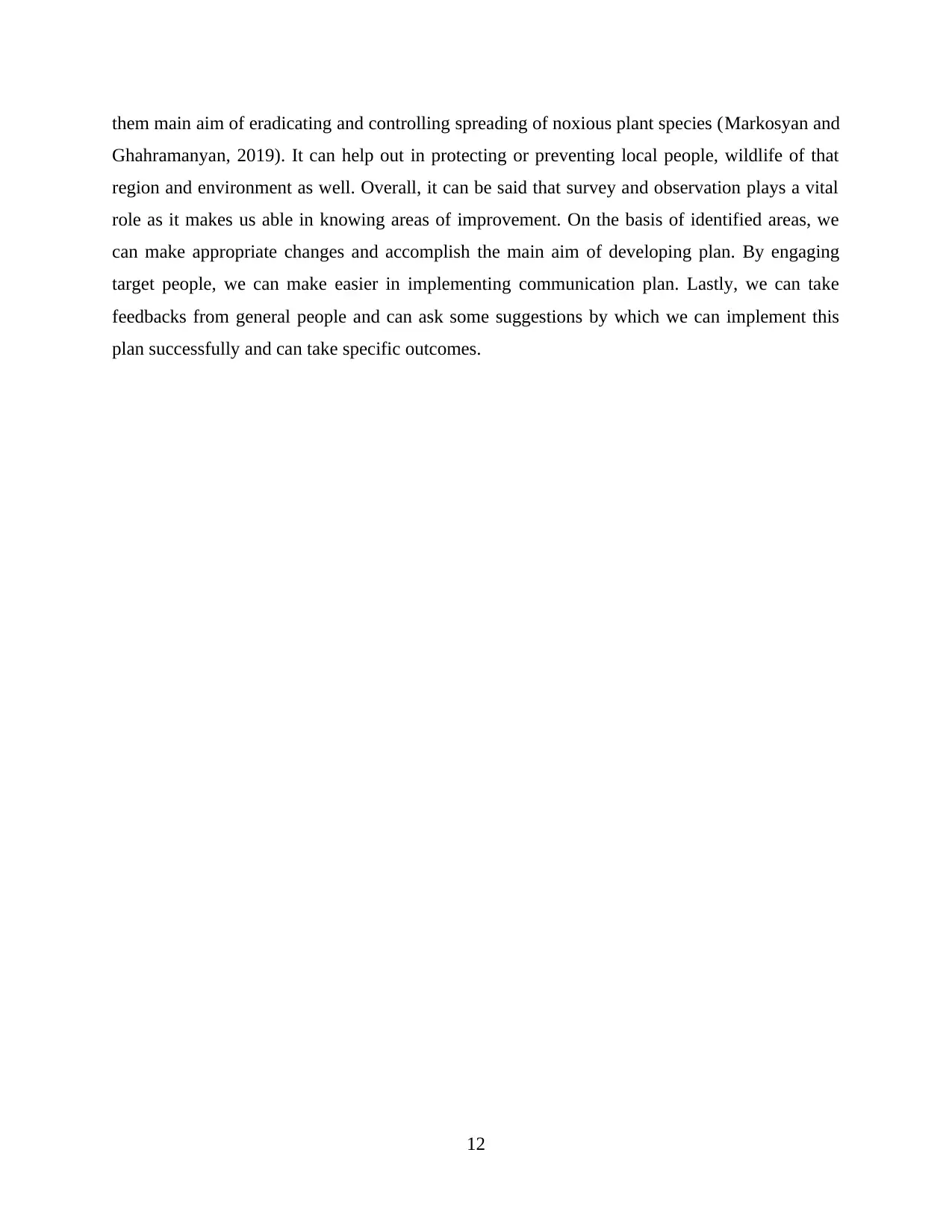
them main aim of eradicating and controlling spreading of noxious plant species (Markosyan and
Ghahramanyan, 2019). It can help out in protecting or preventing local people, wildlife of that
region and environment as well. Overall, it can be said that survey and observation plays a vital
role as it makes us able in knowing areas of improvement. On the basis of identified areas, we
can make appropriate changes and accomplish the main aim of developing plan. By engaging
target people, we can make easier in implementing communication plan. Lastly, we can take
feedbacks from general people and can ask some suggestions by which we can implement this
plan successfully and can take specific outcomes.
12
Ghahramanyan, 2019). It can help out in protecting or preventing local people, wildlife of that
region and environment as well. Overall, it can be said that survey and observation plays a vital
role as it makes us able in knowing areas of improvement. On the basis of identified areas, we
can make appropriate changes and accomplish the main aim of developing plan. By engaging
target people, we can make easier in implementing communication plan. Lastly, we can take
feedbacks from general people and can ask some suggestions by which we can implement this
plan successfully and can take specific outcomes.
12
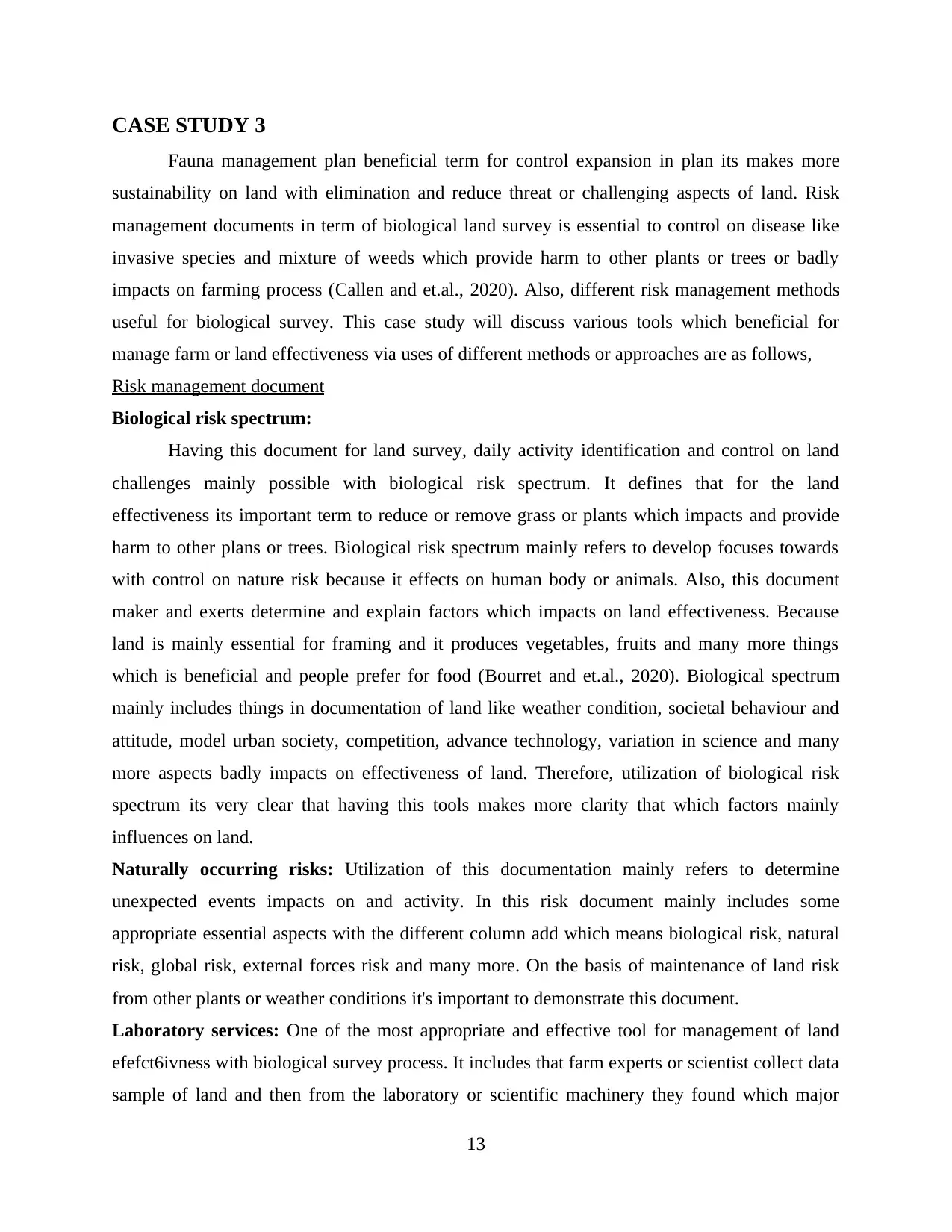
CASE STUDY 3
Fauna management plan beneficial term for control expansion in plan its makes more
sustainability on land with elimination and reduce threat or challenging aspects of land. Risk
management documents in term of biological land survey is essential to control on disease like
invasive species and mixture of weeds which provide harm to other plants or trees or badly
impacts on farming process (Callen and et.al., 2020). Also, different risk management methods
useful for biological survey. This case study will discuss various tools which beneficial for
manage farm or land effectiveness via uses of different methods or approaches are as follows,
Risk management document
Biological risk spectrum:
Having this document for land survey, daily activity identification and control on land
challenges mainly possible with biological risk spectrum. It defines that for the land
effectiveness its important term to reduce or remove grass or plants which impacts and provide
harm to other plans or trees. Biological risk spectrum mainly refers to develop focuses towards
with control on nature risk because it effects on human body or animals. Also, this document
maker and exerts determine and explain factors which impacts on land effectiveness. Because
land is mainly essential for framing and it produces vegetables, fruits and many more things
which is beneficial and people prefer for food (Bourret and et.al., 2020). Biological spectrum
mainly includes things in documentation of land like weather condition, societal behaviour and
attitude, model urban society, competition, advance technology, variation in science and many
more aspects badly impacts on effectiveness of land. Therefore, utilization of biological risk
spectrum its very clear that having this tools makes more clarity that which factors mainly
influences on land.
Naturally occurring risks: Utilization of this documentation mainly refers to determine
unexpected events impacts on and activity. In this risk document mainly includes some
appropriate essential aspects with the different column add which means biological risk, natural
risk, global risk, external forces risk and many more. On the basis of maintenance of land risk
from other plants or weather conditions it's important to demonstrate this document.
Laboratory services: One of the most appropriate and effective tool for management of land
efefct6ivness with biological survey process. It includes that farm experts or scientist collect data
sample of land and then from the laboratory or scientific machinery they found which major
13
Fauna management plan beneficial term for control expansion in plan its makes more
sustainability on land with elimination and reduce threat or challenging aspects of land. Risk
management documents in term of biological land survey is essential to control on disease like
invasive species and mixture of weeds which provide harm to other plants or trees or badly
impacts on farming process (Callen and et.al., 2020). Also, different risk management methods
useful for biological survey. This case study will discuss various tools which beneficial for
manage farm or land effectiveness via uses of different methods or approaches are as follows,
Risk management document
Biological risk spectrum:
Having this document for land survey, daily activity identification and control on land
challenges mainly possible with biological risk spectrum. It defines that for the land
effectiveness its important term to reduce or remove grass or plants which impacts and provide
harm to other plans or trees. Biological risk spectrum mainly refers to develop focuses towards
with control on nature risk because it effects on human body or animals. Also, this document
maker and exerts determine and explain factors which impacts on land effectiveness. Because
land is mainly essential for framing and it produces vegetables, fruits and many more things
which is beneficial and people prefer for food (Bourret and et.al., 2020). Biological spectrum
mainly includes things in documentation of land like weather condition, societal behaviour and
attitude, model urban society, competition, advance technology, variation in science and many
more aspects badly impacts on effectiveness of land. Therefore, utilization of biological risk
spectrum its very clear that having this tools makes more clarity that which factors mainly
influences on land.
Naturally occurring risks: Utilization of this documentation mainly refers to determine
unexpected events impacts on and activity. In this risk document mainly includes some
appropriate essential aspects with the different column add which means biological risk, natural
risk, global risk, external forces risk and many more. On the basis of maintenance of land risk
from other plants or weather conditions it's important to demonstrate this document.
Laboratory services: One of the most appropriate and effective tool for management of land
efefct6ivness with biological survey process. It includes that farm experts or scientist collect data
sample of land and then from the laboratory or scientific machinery they found which major
13
Paraphrase This Document
Need a fresh take? Get an instant paraphrase of this document with our AI Paraphraser
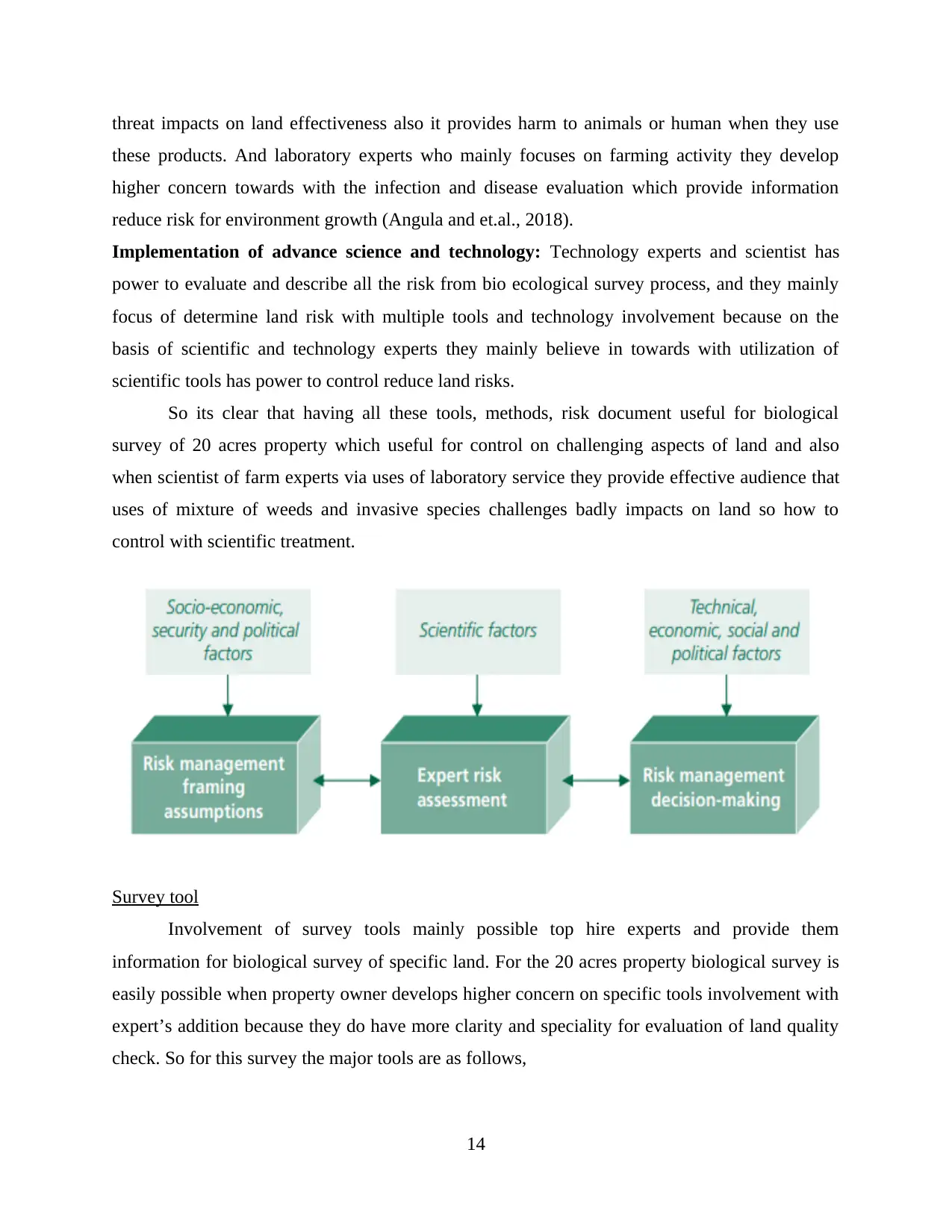
threat impacts on land effectiveness also it provides harm to animals or human when they use
these products. And laboratory experts who mainly focuses on farming activity they develop
higher concern towards with the infection and disease evaluation which provide information
reduce risk for environment growth (Angula and et.al., 2018).
Implementation of advance science and technology: Technology experts and scientist has
power to evaluate and describe all the risk from bio ecological survey process, and they mainly
focus of determine land risk with multiple tools and technology involvement because on the
basis of scientific and technology experts they mainly believe in towards with utilization of
scientific tools has power to control reduce land risks.
So its clear that having all these tools, methods, risk document useful for biological
survey of 20 acres property which useful for control on challenging aspects of land and also
when scientist of farm experts via uses of laboratory service they provide effective audience that
uses of mixture of weeds and invasive species challenges badly impacts on land so how to
control with scientific treatment.
Survey tool
Involvement of survey tools mainly possible top hire experts and provide them
information for biological survey of specific land. For the 20 acres property biological survey is
easily possible when property owner develops higher concern on specific tools involvement with
expert’s addition because they do have more clarity and speciality for evaluation of land quality
check. So for this survey the major tools are as follows,
14
these products. And laboratory experts who mainly focuses on farming activity they develop
higher concern towards with the infection and disease evaluation which provide information
reduce risk for environment growth (Angula and et.al., 2018).
Implementation of advance science and technology: Technology experts and scientist has
power to evaluate and describe all the risk from bio ecological survey process, and they mainly
focus of determine land risk with multiple tools and technology involvement because on the
basis of scientific and technology experts they mainly believe in towards with utilization of
scientific tools has power to control reduce land risks.
So its clear that having all these tools, methods, risk document useful for biological
survey of 20 acres property which useful for control on challenging aspects of land and also
when scientist of farm experts via uses of laboratory service they provide effective audience that
uses of mixture of weeds and invasive species challenges badly impacts on land so how to
control with scientific treatment.
Survey tool
Involvement of survey tools mainly possible top hire experts and provide them
information for biological survey of specific land. For the 20 acres property biological survey is
easily possible when property owner develops higher concern on specific tools involvement with
expert’s addition because they do have more clarity and speciality for evaluation of land quality
check. So for this survey the major tools are as follows,
14
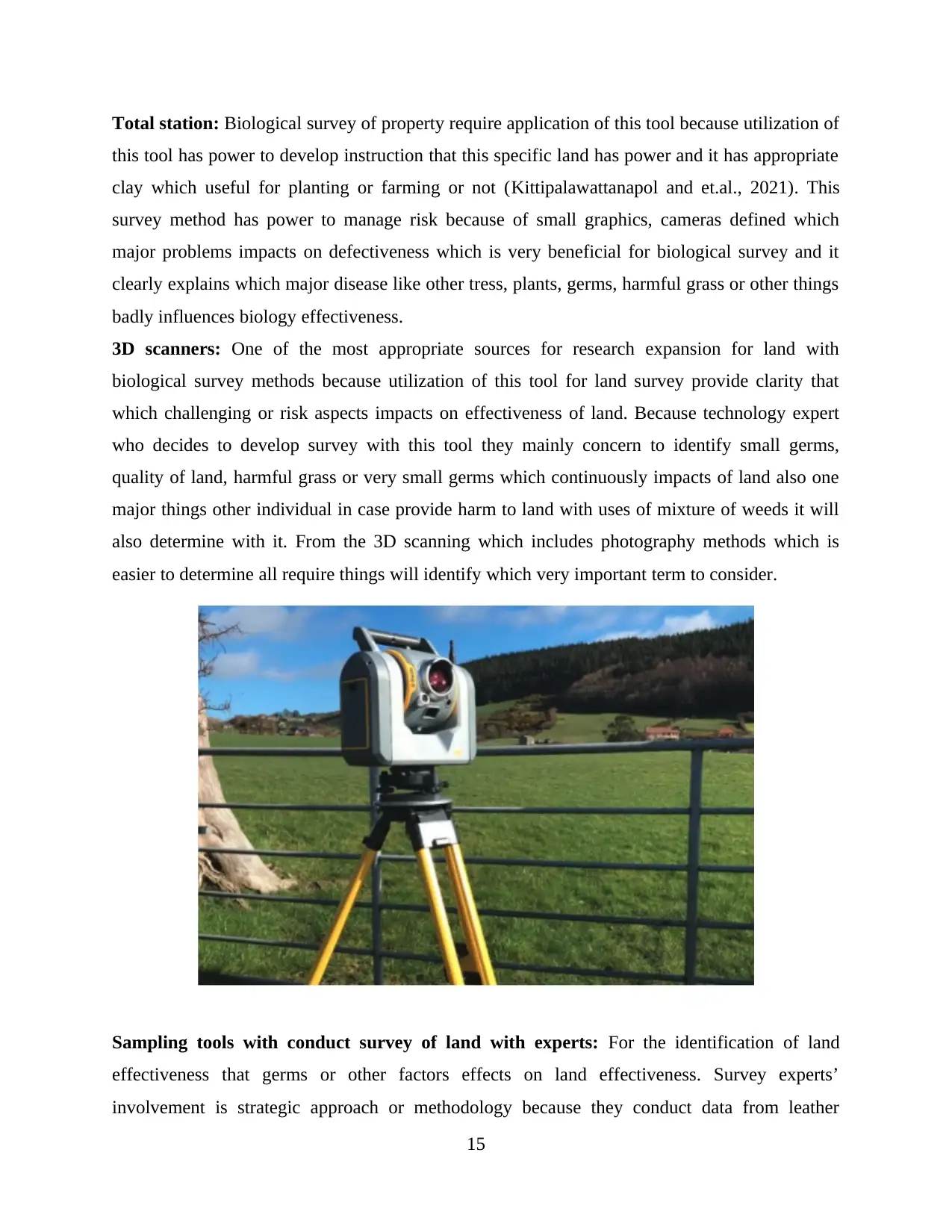
Total station: Biological survey of property require application of this tool because utilization of
this tool has power to develop instruction that this specific land has power and it has appropriate
clay which useful for planting or farming or not (Kittipalawattanapol and et.al., 2021). This
survey method has power to manage risk because of small graphics, cameras defined which
major problems impacts on defectiveness which is very beneficial for biological survey and it
clearly explains which major disease like other tress, plants, germs, harmful grass or other things
badly influences biology effectiveness.
3D scanners: One of the most appropriate sources for research expansion for land with
biological survey methods because utilization of this tool for land survey provide clarity that
which challenging or risk aspects impacts on effectiveness of land. Because technology expert
who decides to develop survey with this tool they mainly concern to identify small germs,
quality of land, harmful grass or very small germs which continuously impacts of land also one
major things other individual in case provide harm to land with uses of mixture of weeds it will
also determine with it. From the 3D scanning which includes photography methods which is
easier to determine all require things will identify which very important term to consider.
Sampling tools with conduct survey of land with experts: For the identification of land
effectiveness that germs or other factors effects on land effectiveness. Survey experts’
involvement is strategic approach or methodology because they conduct data from leather
15
this tool has power to develop instruction that this specific land has power and it has appropriate
clay which useful for planting or farming or not (Kittipalawattanapol and et.al., 2021). This
survey method has power to manage risk because of small graphics, cameras defined which
major problems impacts on defectiveness which is very beneficial for biological survey and it
clearly explains which major disease like other tress, plants, germs, harmful grass or other things
badly influences biology effectiveness.
3D scanners: One of the most appropriate sources for research expansion for land with
biological survey methods because utilization of this tool for land survey provide clarity that
which challenging or risk aspects impacts on effectiveness of land. Because technology expert
who decides to develop survey with this tool they mainly concern to identify small germs,
quality of land, harmful grass or very small germs which continuously impacts of land also one
major things other individual in case provide harm to land with uses of mixture of weeds it will
also determine with it. From the 3D scanning which includes photography methods which is
easier to determine all require things will identify which very important term to consider.
Sampling tools with conduct survey of land with experts: For the identification of land
effectiveness that germs or other factors effects on land effectiveness. Survey experts’
involvement is strategic approach or methodology because they conduct data from leather
15
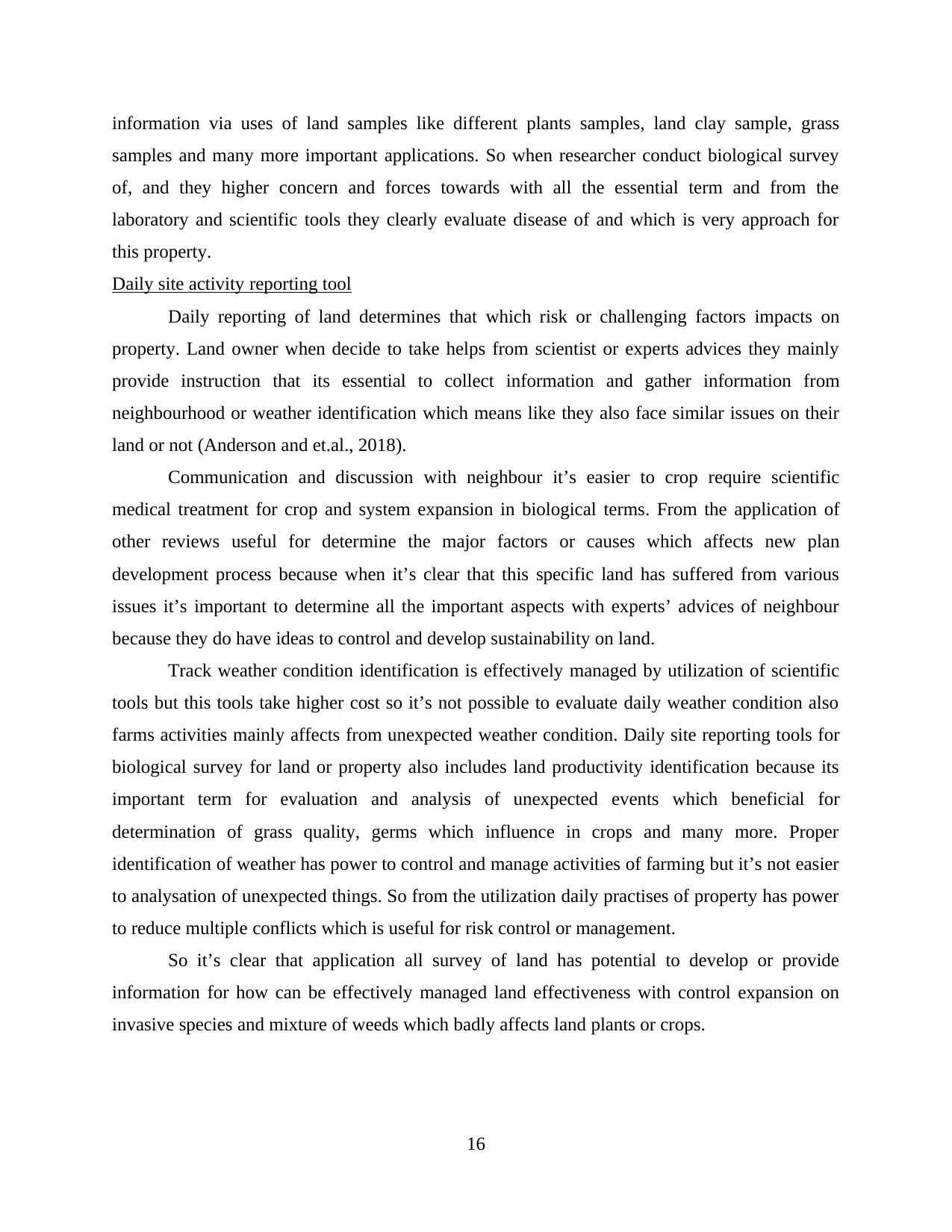
information via uses of land samples like different plants samples, land clay sample, grass
samples and many more important applications. So when researcher conduct biological survey
of, and they higher concern and forces towards with all the essential term and from the
laboratory and scientific tools they clearly evaluate disease of and which is very approach for
this property.
Daily site activity reporting tool
Daily reporting of land determines that which risk or challenging factors impacts on
property. Land owner when decide to take helps from scientist or experts advices they mainly
provide instruction that its essential to collect information and gather information from
neighbourhood or weather identification which means like they also face similar issues on their
land or not (Anderson and et.al., 2018).
Communication and discussion with neighbour it’s easier to crop require scientific
medical treatment for crop and system expansion in biological terms. From the application of
other reviews useful for determine the major factors or causes which affects new plan
development process because when it’s clear that this specific land has suffered from various
issues it’s important to determine all the important aspects with experts’ advices of neighbour
because they do have ideas to control and develop sustainability on land.
Track weather condition identification is effectively managed by utilization of scientific
tools but this tools take higher cost so it’s not possible to evaluate daily weather condition also
farms activities mainly affects from unexpected weather condition. Daily site reporting tools for
biological survey for land or property also includes land productivity identification because its
important term for evaluation and analysis of unexpected events which beneficial for
determination of grass quality, germs which influence in crops and many more. Proper
identification of weather has power to control and manage activities of farming but it’s not easier
to analysation of unexpected things. So from the utilization daily practises of property has power
to reduce multiple conflicts which is useful for risk control or management.
So it’s clear that application all survey of land has potential to develop or provide
information for how can be effectively managed land effectiveness with control expansion on
invasive species and mixture of weeds which badly affects land plants or crops.
16
samples and many more important applications. So when researcher conduct biological survey
of, and they higher concern and forces towards with all the essential term and from the
laboratory and scientific tools they clearly evaluate disease of and which is very approach for
this property.
Daily site activity reporting tool
Daily reporting of land determines that which risk or challenging factors impacts on
property. Land owner when decide to take helps from scientist or experts advices they mainly
provide instruction that its essential to collect information and gather information from
neighbourhood or weather identification which means like they also face similar issues on their
land or not (Anderson and et.al., 2018).
Communication and discussion with neighbour it’s easier to crop require scientific
medical treatment for crop and system expansion in biological terms. From the application of
other reviews useful for determine the major factors or causes which affects new plan
development process because when it’s clear that this specific land has suffered from various
issues it’s important to determine all the important aspects with experts’ advices of neighbour
because they do have ideas to control and develop sustainability on land.
Track weather condition identification is effectively managed by utilization of scientific
tools but this tools take higher cost so it’s not possible to evaluate daily weather condition also
farms activities mainly affects from unexpected weather condition. Daily site reporting tools for
biological survey for land or property also includes land productivity identification because its
important term for evaluation and analysis of unexpected events which beneficial for
determination of grass quality, germs which influence in crops and many more. Proper
identification of weather has power to control and manage activities of farming but it’s not easier
to analysation of unexpected things. So from the utilization daily practises of property has power
to reduce multiple conflicts which is useful for risk control or management.
So it’s clear that application all survey of land has potential to develop or provide
information for how can be effectively managed land effectiveness with control expansion on
invasive species and mixture of weeds which badly affects land plants or crops.
16
Secure Best Marks with AI Grader
Need help grading? Try our AI Grader for instant feedback on your assignments.
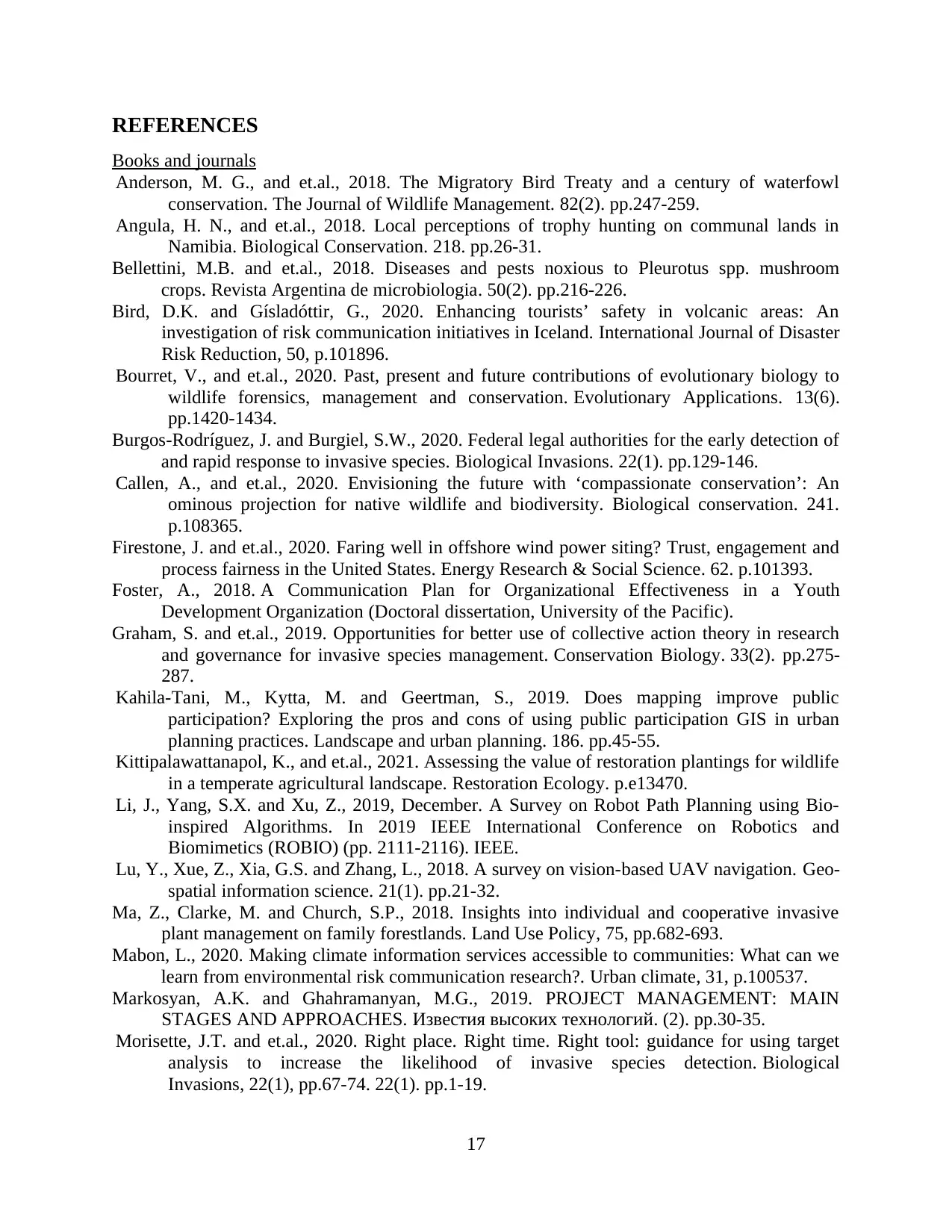
REFERENCES
Books and journals
Anderson, M. G., and et.al., 2018. The Migratory Bird Treaty and a century of waterfowl
conservation. The Journal of Wildlife Management. 82(2). pp.247-259.
Angula, H. N., and et.al., 2018. Local perceptions of trophy hunting on communal lands in
Namibia. Biological Conservation. 218. pp.26-31.
Bellettini, M.B. and et.al., 2018. Diseases and pests noxious to Pleurotus spp. mushroom
crops. Revista Argentina de microbiologia. 50(2). pp.216-226.
Bird, D.K. and Gísladóttir, G., 2020. Enhancing tourists’ safety in volcanic areas: An
investigation of risk communication initiatives in Iceland. International Journal of Disaster
Risk Reduction, 50, p.101896.
Bourret, V., and et.al., 2020. Past, present and future contributions of evolutionary biology to
wildlife forensics, management and conservation. Evolutionary Applications. 13(6).
pp.1420-1434.
Burgos-Rodríguez, J. and Burgiel, S.W., 2020. Federal legal authorities for the early detection of
and rapid response to invasive species. Biological Invasions. 22(1). pp.129-146.
Callen, A., and et.al., 2020. Envisioning the future with ‘compassionate conservation’: An
ominous projection for native wildlife and biodiversity. Biological conservation. 241.
p.108365.
Firestone, J. and et.al., 2020. Faring well in offshore wind power siting? Trust, engagement and
process fairness in the United States. Energy Research & Social Science. 62. p.101393.
Foster, A., 2018. A Communication Plan for Organizational Effectiveness in a Youth
Development Organization (Doctoral dissertation, University of the Pacific).
Graham, S. and et.al., 2019. Opportunities for better use of collective action theory in research
and governance for invasive species management. Conservation Biology. 33(2). pp.275-
287.
Kahila-Tani, M., Kytta, M. and Geertman, S., 2019. Does mapping improve public
participation? Exploring the pros and cons of using public participation GIS in urban
planning practices. Landscape and urban planning. 186. pp.45-55.
Kittipalawattanapol, K., and et.al., 2021. Assessing the value of restoration plantings for wildlife
in a temperate agricultural landscape. Restoration Ecology. p.e13470.
Li, J., Yang, S.X. and Xu, Z., 2019, December. A Survey on Robot Path Planning using Bio-
inspired Algorithms. In 2019 IEEE International Conference on Robotics and
Biomimetics (ROBIO) (pp. 2111-2116). IEEE.
Lu, Y., Xue, Z., Xia, G.S. and Zhang, L., 2018. A survey on vision-based UAV navigation. Geo-
spatial information science. 21(1). pp.21-32.
Ma, Z., Clarke, M. and Church, S.P., 2018. Insights into individual and cooperative invasive
plant management on family forestlands. Land Use Policy, 75, pp.682-693.
Mabon, L., 2020. Making climate information services accessible to communities: What can we
learn from environmental risk communication research?. Urban climate, 31, p.100537.
Markosyan, A.K. and Ghahramanyan, M.G., 2019. PROJECT MANAGEMENT: MAIN
STAGES AND APPROACHES. Известия высоких технологий. (2). pp.30-35.
Morisette, J.T. and et.al., 2020. Right place. Right time. Right tool: guidance for using target
analysis to increase the likelihood of invasive species detection. Biological
Invasions, 22(1), pp.67-74. 22(1). pp.1-19.
17
Books and journals
Anderson, M. G., and et.al., 2018. The Migratory Bird Treaty and a century of waterfowl
conservation. The Journal of Wildlife Management. 82(2). pp.247-259.
Angula, H. N., and et.al., 2018. Local perceptions of trophy hunting on communal lands in
Namibia. Biological Conservation. 218. pp.26-31.
Bellettini, M.B. and et.al., 2018. Diseases and pests noxious to Pleurotus spp. mushroom
crops. Revista Argentina de microbiologia. 50(2). pp.216-226.
Bird, D.K. and Gísladóttir, G., 2020. Enhancing tourists’ safety in volcanic areas: An
investigation of risk communication initiatives in Iceland. International Journal of Disaster
Risk Reduction, 50, p.101896.
Bourret, V., and et.al., 2020. Past, present and future contributions of evolutionary biology to
wildlife forensics, management and conservation. Evolutionary Applications. 13(6).
pp.1420-1434.
Burgos-Rodríguez, J. and Burgiel, S.W., 2020. Federal legal authorities for the early detection of
and rapid response to invasive species. Biological Invasions. 22(1). pp.129-146.
Callen, A., and et.al., 2020. Envisioning the future with ‘compassionate conservation’: An
ominous projection for native wildlife and biodiversity. Biological conservation. 241.
p.108365.
Firestone, J. and et.al., 2020. Faring well in offshore wind power siting? Trust, engagement and
process fairness in the United States. Energy Research & Social Science. 62. p.101393.
Foster, A., 2018. A Communication Plan for Organizational Effectiveness in a Youth
Development Organization (Doctoral dissertation, University of the Pacific).
Graham, S. and et.al., 2019. Opportunities for better use of collective action theory in research
and governance for invasive species management. Conservation Biology. 33(2). pp.275-
287.
Kahila-Tani, M., Kytta, M. and Geertman, S., 2019. Does mapping improve public
participation? Exploring the pros and cons of using public participation GIS in urban
planning practices. Landscape and urban planning. 186. pp.45-55.
Kittipalawattanapol, K., and et.al., 2021. Assessing the value of restoration plantings for wildlife
in a temperate agricultural landscape. Restoration Ecology. p.e13470.
Li, J., Yang, S.X. and Xu, Z., 2019, December. A Survey on Robot Path Planning using Bio-
inspired Algorithms. In 2019 IEEE International Conference on Robotics and
Biomimetics (ROBIO) (pp. 2111-2116). IEEE.
Lu, Y., Xue, Z., Xia, G.S. and Zhang, L., 2018. A survey on vision-based UAV navigation. Geo-
spatial information science. 21(1). pp.21-32.
Ma, Z., Clarke, M. and Church, S.P., 2018. Insights into individual and cooperative invasive
plant management on family forestlands. Land Use Policy, 75, pp.682-693.
Mabon, L., 2020. Making climate information services accessible to communities: What can we
learn from environmental risk communication research?. Urban climate, 31, p.100537.
Markosyan, A.K. and Ghahramanyan, M.G., 2019. PROJECT MANAGEMENT: MAIN
STAGES AND APPROACHES. Известия высоких технологий. (2). pp.30-35.
Morisette, J.T. and et.al., 2020. Right place. Right time. Right tool: guidance for using target
analysis to increase the likelihood of invasive species detection. Biological
Invasions, 22(1), pp.67-74. 22(1). pp.1-19.
17
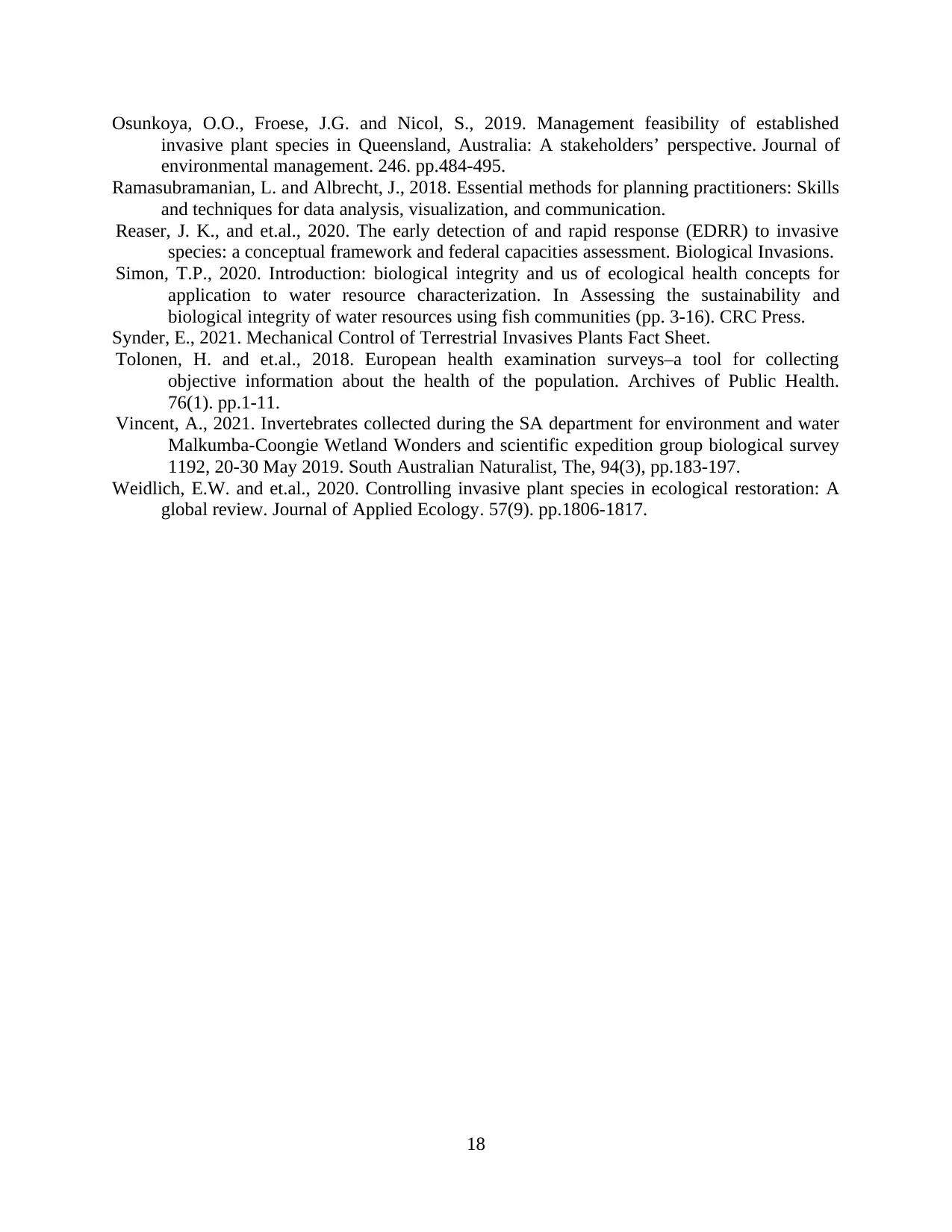
Osunkoya, O.O., Froese, J.G. and Nicol, S., 2019. Management feasibility of established
invasive plant species in Queensland, Australia: A stakeholders’ perspective. Journal of
environmental management. 246. pp.484-495.
Ramasubramanian, L. and Albrecht, J., 2018. Essential methods for planning practitioners: Skills
and techniques for data analysis, visualization, and communication.
Reaser, J. K., and et.al., 2020. The early detection of and rapid response (EDRR) to invasive
species: a conceptual framework and federal capacities assessment. Biological Invasions.
Simon, T.P., 2020. Introduction: biological integrity and us of ecological health concepts for
application to water resource characterization. In Assessing the sustainability and
biological integrity of water resources using fish communities (pp. 3-16). CRC Press.
Synder, E., 2021. Mechanical Control of Terrestrial Invasives Plants Fact Sheet.
Tolonen, H. and et.al., 2018. European health examination surveys–a tool for collecting
objective information about the health of the population. Archives of Public Health.
76(1). pp.1-11.
Vincent, A., 2021. Invertebrates collected during the SA department for environment and water
Malkumba-Coongie Wetland Wonders and scientific expedition group biological survey
1192, 20-30 May 2019. South Australian Naturalist, The, 94(3), pp.183-197.
Weidlich, E.W. and et.al., 2020. Controlling invasive plant species in ecological restoration: A
global review. Journal of Applied Ecology. 57(9). pp.1806-1817.
18
invasive plant species in Queensland, Australia: A stakeholders’ perspective. Journal of
environmental management. 246. pp.484-495.
Ramasubramanian, L. and Albrecht, J., 2018. Essential methods for planning practitioners: Skills
and techniques for data analysis, visualization, and communication.
Reaser, J. K., and et.al., 2020. The early detection of and rapid response (EDRR) to invasive
species: a conceptual framework and federal capacities assessment. Biological Invasions.
Simon, T.P., 2020. Introduction: biological integrity and us of ecological health concepts for
application to water resource characterization. In Assessing the sustainability and
biological integrity of water resources using fish communities (pp. 3-16). CRC Press.
Synder, E., 2021. Mechanical Control of Terrestrial Invasives Plants Fact Sheet.
Tolonen, H. and et.al., 2018. European health examination surveys–a tool for collecting
objective information about the health of the population. Archives of Public Health.
76(1). pp.1-11.
Vincent, A., 2021. Invertebrates collected during the SA department for environment and water
Malkumba-Coongie Wetland Wonders and scientific expedition group biological survey
1192, 20-30 May 2019. South Australian Naturalist, The, 94(3), pp.183-197.
Weidlich, E.W. and et.al., 2020. Controlling invasive plant species in ecological restoration: A
global review. Journal of Applied Ecology. 57(9). pp.1806-1817.
18
1 out of 18
Related Documents
Your All-in-One AI-Powered Toolkit for Academic Success.
+13062052269
info@desklib.com
Available 24*7 on WhatsApp / Email
![[object Object]](/_next/static/media/star-bottom.7253800d.svg)
Unlock your academic potential
© 2024 | Zucol Services PVT LTD | All rights reserved.




